Recent Advances in Recoverable Systems for the Copper-Catalyzed Azide-Alkyne Cycloaddition Reaction (CuAAC)
Abstract
:1. Introduction
- Alkyl halides (Scheme 2a), often of the “activated” type (benzyl, allyl, α-halocarbonyls) with respect to the nucleophilic substitution reaction;
- Epoxides (Scheme 2b), which can lead to the formation of differently substituted triazoles (3 and 4) in dependence of the regioselectivity of attack of azide ions on the oxirane ring;
- Aromatic diazonium salts (Scheme 2c), either commercially available (e.g., tetrafluoroborate salts) or produced in situ by diazotisation of the corresponding aromatic amine;
2. Cu, Cu2O, CuO, and CuX Nanoparticles and Nanocomposites
2.1. Carbon Supports
2.2. Insoluble Synthetic Organic Polymers
2.3. Metal-Organic Frameworks
2.4. Polymers from Natural Sources
2.5. Oxides and Other Inorganic Supports
2.6. Magnetically Recoverable Systems
2.7. Polymer-Stabilized Soluble Systems and Quasi-Homogeneous CuNPs
3. Discrete Cu(I/II) Complexes
3.1. Cross-Linked Synthetic Organic Polymer Supports
3.2. Polymeric Organic Supports from Natural Sources
3.3. Linear Organic Polymer Supports
3.4. Inorganic Supports
3.5. Magnetically Recoverable Systems
4. Cu-Exchanged Clays and Other Inorganic Materials
5. Conclusions
Acknowledgments
Conflicts of Interest
Abbreviations
| AAS | Atomic absorption spectroscopy |
| AES | Atomic emission spectroscopy |
| Bipy | 4,4′-Bipyridine |
| CD | Cyclodextrin |
| CNT | carbon nano-tubes |
| CP-MASS | Cross-polarization magic angle spinning spectroscopy |
| CRGO | Chemically-reduced graphene oxide |
| CS | Chitosan |
| CuAAC | Copper-catalyzed azide-alkyne cycloaddition |
| CuNPs | Copper nanoparticles |
| DMF | N,N-Dimethylformamide |
| DMSO | Dimethylsulfoxide |
| DVB | divinylbenzene |
| EDACell | Ethylenediamine-modified cellulose |
| EDS | Energy-dispersive (X-ray) spectroscopy |
| FT-IR | Fourier-transform infra-red spectroscopy |
| GO | Graphene oxide |
| Himdc | 4,5-Imidazoledicarboxylate |
| HPA | Heteropolyacid |
| ICP | Inductively-coupled plasma |
| LDH | Layered double hydroxide |
| M-dots | Melanine nanoparticles |
| MOF | Metal-organic framework |
| MS | Mass spectrometry |
| MW | Microwave, molecular weight |
| NHC | N-Heterocyclic carbene |
| OES | Optical emission spectroscopy |
| pABA | Poly(2-aminobenzoic acid) |
| PANI | Polyaniline |
| PIB | Poly(isobutylene) |
| PEG | Poly(ethylene glycol), poly(ethylene oxide) |
| Pim | Poly(vinyl imidazole) |
| p[C4R-NH2] | amine-modified calix[4]resorcinarene-formaldehyde resin |
| P[im/IL] | Imidazole-ionic liquid copolymer |
| PMMA | Poly(methyl methacrylate) |
| POM | Polyoxometalate |
| ppm, ppb | parts per milion, parts per bilion |
| PTFE | Poly(tetrafluoroethylene) |
| PVA | Poly(vinyl alcohol) |
| PVP | Poly(N-vinyl pyrrolidone) |
| PVPh | Poly(4-vinylphenol) |
| r.t. | Room temperature |
| SEM | Scanning electron microscopy |
| SMI | Poly(styrene-co-maleic anhydride) imide |
| SNW | Schiff-base network polymer |
| TBTA | Tris[(1-benzyl-1,2,3-triazole-4-yl)methyl]amine |
| TEM | Transmission electron microscopy |
| TGA | Thermogravimetric analysis |
| THF | Tetrahydrofurane |
| TOF | Turnover frequency |
| TON | Turnover number |
| UV | Ultraviolet spectroscopy |
| XPS | X-ray photoelectron spectroscopy |
| XRD | X-ray (powder) diffraction analysis |
| XRF | X-ray fluorescence analysis |
References
- Kolb, H.C.; Finn, M.G.; Sharpless, K.B. Click chemistry: Diverse chemical function from a few good reactions. Angew. Chem. Int. Ed. Engl. 2001, 40, 2004–2021. [Google Scholar] [CrossRef]
- Tornoe, C.W.; Christensen, C.; Meldal, M. Peptidotriazoles on solid phase: [1,2,3]-triazoles by regiospecific copper(I)-catalyzed 1,3-dipolar cycloadditions of terminal alkynes to azides. J. Org. Chem. 2002, 67, 3057–3064. [Google Scholar] [CrossRef] [PubMed]
- Rostovtsev, V.V.; Green, L.G.; Fokin, V.V.; Sharpless, K.B. A stepwise Huisgen cycloaddition process: Copper(I)-catalyzed regioselective “ligation” of azides and terminal alkynes. Angew. Chem. Int. Ed. Engl. 2002, 41, 2596–2599. [Google Scholar] [CrossRef]
- Gil, M.V.; Arevalo, M.J.; Lopez, O. Click chemistry—What’s in a name? Triazole synthesis and beyond. Synthesis 2007, 1589–1620. [Google Scholar] [CrossRef]
- Tong, R.; Tang, L.; Ma, L.; Tu, C.; Baumgartner, R.; Cheng, J. Smart chemistry in polymeric nanomedicine. Chem. Soc. Rev. 2014, 43, 6982–7012. [Google Scholar] [CrossRef] [PubMed]
- Golas, P.L.; Matyjaszewski, K. Marrying click chemistry with polymerization: Expanding the scope of polymeric materials. Chem. Soc. Rev. 2010, 39, 1338–1354. [Google Scholar] [CrossRef] [PubMed]
- Mansfeld, U.; Pietsch, C.; Hoogenboom, R.; Becer, C.R.; Schubert, U.S. Clickable initiators, monomers and polymers in controlled radical polymerizations—A prospective combination in polymer science. Polym. Chem. 2010, 1, 1560–1598. [Google Scholar] [CrossRef]
- Sumerlin, B.S.; Vogt, A.P. Macromolecular engineering through click chemistry and other efficient transformations. Macromolecules 2010, 43. [Google Scholar] [CrossRef]
- Delaittre, G.; Guimard, N.K.; Barner-Kowollik, C. Cycloadditions in modern polymer chemistry. Acc. Chem. Res. 2015, 48, 1296–1307. [Google Scholar] [CrossRef] [PubMed]
- Espeel, P.; Du Prez, F.E. “Click”-inspired chemistry in macromolecular science: Matching recent progress and user expectations. Macromolecules 2015, 48. [Google Scholar] [CrossRef]
- Altintas, O.; Vogt, A.P.; Barner-Kowollik, C.; Tunca, U. Constructing star polymers via modular ligation strategies. Polym. Chem. 2012, 3, 34–45. [Google Scholar] [CrossRef]
- Chow, H.-F.; Lo, C.-M.; Chen, Y. Triazole-based polymer gels. Top. Heterocycl. Chem. 2012, 28, 137–162. [Google Scholar]
- Wan, L.; Cai, C. Multicomponent synthesis of 1,2,3-triazoles in water catalyzed by silica-immobilized NHC-Cu(I). Catal. Lett. 2012, 142, 1134–1140. [Google Scholar] [CrossRef]
- Zheng, Y.; Li, S.; Weng, Z.; Gao, C. Hyperbranched polymers: Advances from synthesis to applications. Chem. Soc. Rev. 2015, 44, 4091–4130. [Google Scholar] [CrossRef] [PubMed]
- Pasini, D. The click reaction as an efficient tool for the construction of macrocyclic structures. Molecules 2013, 18, 9512–9530. [Google Scholar] [CrossRef] [PubMed]
- Pangilinan, K.; Advincula, R. Cyclic polymers and catenanes by atom transfer radical polymerization (ATRP). Polym. Int. 2014, 63, 803–813. [Google Scholar] [CrossRef]
- Schumers, J.-M.; Gohy, J.-F.; Fustin, C.-A. A versatile strategy for the synthesis of block copolymers bearing a photocleavable junction. Polym. Chem. 2010, 1, 161–163. [Google Scholar] [CrossRef]
- Michael, P.; Binder, W.H. A mechanochemically triggered “click” catalyst. Angew. Chem. Int. Ed. 2015, 54, 13918–13922. [Google Scholar] [CrossRef] [PubMed]
- Rana, S.; Cho, J.W. Functionalization of carbon nanotubes via Cu(I)-catalyzed Huisgen [3+2] cycloaddition “click chemistry”. Nanoscale 2010, 2, 2550–2556. [Google Scholar] [CrossRef] [PubMed]
- Segura, J.L.; Castelain, M.; Salavagione, H. Synthesis and properties of [60]fullerene derivatives functionalized through copper catalyzed Huisgen cycloaddition reactions. Curr. Org. Synth. 2013, 10, 724–736. [Google Scholar] [CrossRef]
- Segura, J.L.; Salavagione, H.J. Graphene in copper catalyzed azide-alkyne cycloaddition reactions: Evolution from [60]fullerene and carbon nanotubes strategies. Curr. Org. Chem. 2013, 17, 1680–1693. [Google Scholar] [CrossRef]
- Chen, Y.-X.; Triola, G.; Waldmann, H. Bioorthogonal chemistry for site-specific labeling and surface immobilization of proteins. Acc. Chem. Res. 2011, 44, 762–773. [Google Scholar] [CrossRef] [PubMed]
- Li, Y.; Cai, C. Click chemistry-based functionalization on non-oxidized silicon substrates. Chem. Asian J. 2011, 6, 2592–2605. [Google Scholar] [CrossRef] [PubMed]
- Deng, X.; Lahann, J. Orthogonal surface functionalization through bioactive vapor-based polymer coatings. J. Appl. Polym. Sci. 2014, 131, 40315–40323. [Google Scholar] [CrossRef]
- Kantheti, S.; Narayan, R.; Raju, K.V.S.N. The impact of 1,2,3-triazoles in the design of functional coatings. RSC Adv. 2015, 5, 3687–3708. [Google Scholar] [CrossRef]
- Accurso, A.A.; Delaney, M.; O’Brien, J.; Kim, H.; Iovine, P.M.; Díaz, D.D.; Finn, M.G. Improved metal-adhesive polymers from copper(I)-catalyzed azide–alkyne cycloaddition. Chem. Eur. J. 2014, 20, 10710–10719. [Google Scholar] [CrossRef] [PubMed]
- Hein, J.E.; Fokin, V.V. Copper-catalyzed azide–alkyne cycloaddition (CuAAC) and beyond: New reactivity of copper(I) acetylides. Chem. Soc. Rev. 2010, 39, 1302–1315. [Google Scholar] [CrossRef] [PubMed]
- Jin, L.; Tolentino, D.R.; Melaimi, M.; Bertrand, G. Isolation of bis(copper) key intermediates in Cu-catalyzed azide-alkyne “click reaction”. Sci. Adv. 2015, 1, e1500304. [Google Scholar] [CrossRef] [PubMed]
- Makarem, A.; Berg, R.; Rominger, F.; Straub, B.F. A fluxional copper acetylide cluster in CuAAC catalysis. Angew. Chem. Int. Ed. Engl. 2015, 54, 7431–7435. [Google Scholar] [CrossRef] [PubMed]
- Wang, C.; Ikhlef, D.; Kahlal, S.; Saillard, J.-Y.; Astruc, D. Metal-catalyzed azide-alkyne “click” reactions: Mechanistic overview and recent trends. Coord. Chem. Rev. 2016, 316. [Google Scholar] [CrossRef]
- Otvos, S.B.; Fulop, F. Flow chemistry as a versatile tool for the synthesis of triazoles. Catal. Sci. Technol. 2015, 5, 4926–4941. [Google Scholar] [CrossRef]
- Kappe, C.O.; van der Eycken, E. Click chemistry under non-classical reaction conditions. Chem. Soc. Rev. 2010, 39, 1280–1290. [Google Scholar] [CrossRef] [PubMed]
- Pistara, V.; Rescifina, A.; Chiacchio, M.A.; Corsaro, A. Use of microwave heating in the synthesis of heterocycles from carbohydrates. Curr. Org. Chem. 2014, 18, 417–445. [Google Scholar] [CrossRef]
- Brittain, W.D.G.; Buckley, B.R.; Fossey, J.S. Asymmetric copper-catalyzed azide-alkyne cycloadditions. ACS Catal. 2016, 6, 3629–3636. [Google Scholar] [CrossRef]
- Chen, M.-Y.; Song, T.; Zheng, Z.-J.; Xu, Z.; Cui, Y.-M.; Xu, L.-W. Tao-phos-controlled desymmetrization of succinimide-based bisalkynes via asymmetric copper-catalyzed Huisgen alkyne-azide click cycloaddition: Substrate scope and mechanism. RSC Adv. 2016, 6, 58698–58708. [Google Scholar] [CrossRef]
- Van Dijk, M.; Rijkers, D.T.S.; Liskamp, R.M.J.; van Nostrum, C.F.; Hennink, W.E. Synthesis and applications of biomedical and pharmaceutical polymers via click chemistry methodologies. Bioconjugate Chem. 2009, 20, 2001–2016. [Google Scholar] [CrossRef] [PubMed]
- Nimmo, C.M.; Shoichet, M.S. Regenerative biomaterials that “click”: Simple, aqueous-based protocols for hydrogel synthesis, surface immobilization, and 3D patterning. Bioconjugate Chem. 2011, 22, 2199–2209. [Google Scholar] [CrossRef] [PubMed]
- Hvilsted, S. Facile design of biomaterials by click chemistry. Polym. Int. 2012, 61, 485–494. [Google Scholar] [CrossRef]
- Tron, G.C.; Pirali, T.; Billington, R.A.; Canonico, P.L.; Sorba, G.; Genazzani, A.A. Click chemistry reactions in medicinal chemistry: Applications of the 1,3-dipolar cycloaddition between azides and alkynes. Med. Res. Rev. 2008, 28, 278–308. [Google Scholar] [CrossRef] [PubMed]
- Thirumurugan, P.; Matosiuk, D.; Jozwiak, K. Click chemistry for drug development and diverse chemical-biology applications. Chem. Rev. 2013, 113, 4905–4979. [Google Scholar] [CrossRef] [PubMed]
- Lutz, J.-F.; Zarafshani, Z. Efficient construction of therapeutics, bioconjugates, biomaterials and bioactive surfaces using azide-alkyne “click” chemistry. Adv. Drug Deliv. Rev. 2008, 60, 958–970. [Google Scholar] [CrossRef] [PubMed]
- Zhou, C.H.; Wang, Y. Recent researches in triazole compounds as medicinal drugs. Curr. Med. Chem. 2012, 19, 239–280. [Google Scholar] [CrossRef] [PubMed]
- Sokolova, N.V.; Nenajdenko, V.G. Recent advances in the Cu(I)-catalyzed azide-alkyne cycloaddition: Focus on functionally substituted azides and alkynes. RSC Adv. 2013, 3, 16212–16242. [Google Scholar] [CrossRef]
- Holub, J.M.; Kirshenbaum, K. Tricks with clicks: Modification of peptidomimetic oligomers via copper-catalyzed azide-alkyne [3+2] cycloaddition. Chem. Soc. Rev. 2010, 39, 1325–1337. [Google Scholar] [CrossRef] [PubMed]
- Meldal, M.; Tornoee, C.W.; Nielsen, T.E.; Diness, F.; Le Quement, S.T.; Christensen, C.A.; Jensen, J.F.; Worm-Leonhard, K.; Groth, T.; Bouakaz, L.; et al. Hirschmann award address 2009: Merger of organic chemistry with peptide diversity. Biopolymers 2010, 94, 161–182. [Google Scholar] [CrossRef] [PubMed]
- Chan-Seng, D.; Lutz, J.-F. Solid-phase synthesis as a tool for the preparation of sequence-defined oligomers based on natural amino acids and synthetic building blocks. ACS Symp. Ser. 2014, 1170, 103–116. [Google Scholar]
- Aragão-Leoneti, V.; Campo, V.L.; Gomes, A.S.; Field, R.A.; Carvalho, I. Application of copper(I)-catalysed azide/alkyne cycloaddition (CuAAC) “click chemistry” in carbohydrate drug and neoglycopolymer synthesis. Tetrahedron 2010, 66, 9475–9492. [Google Scholar] [CrossRef]
- Elchinger, P.-H.; Faugeras, P.-A.; Boens, B.; Brouillette, F.; Montplaisir, D.; Zerrouki, R.; Lucas, R. Polysaccharides: The “click” chemistry impact. Polymers 2011, 3, 1607–1651. [Google Scholar] [CrossRef]
- Tiwari, V.K.; Mishra, B.B.; Mishra, K.B.; Mishra, N.; Singh, A.S.; Chen, X. Cu-catalyzed click reaction in carbohydrate chemistry. Chem. Rev. 2016, 116, 3086–3240. [Google Scholar] [CrossRef] [PubMed]
- Amblard, F.; Cho, J.H.; Schinazi, R.F. Cu(I)-catalyzed Huisgen azide-alkyne 1,3-dipolar cycloaddition reaction in nucleoside, nucleotide, and oligonucleotide chemistry. Chem. Rev. 2009, 109, 4207–4220. [Google Scholar] [CrossRef] [PubMed]
- Kore, A.R.; Charles, I. Click chemistry based functionalizations of nucleoside, nucleotide and nucleic acids. Curr. Org. Chem. 2013, 17, 2164–2191. [Google Scholar] [CrossRef]
- Harju, K.; Yli-Kauhaluoma, J. Recent advances in 1,3-dipolar cycloaddition reactions on solid supports. Mol. Divers. 2005, 9, 187–207. [Google Scholar] [CrossRef] [PubMed]
- Castro, V.; Rodríguez, H.; Albericio, F. CuAAC: An efficient click chemistry reaction on solid phase. ACS Comb. Sci. 2016, 18. [Google Scholar] [CrossRef] [PubMed]
- Fernandes, A.E.; Jonas, A.M.; Riant, O. Application of CuAAC for the covalent immobilization of homogeneous catalysts. Tetrahedron 2014, 70, 1709–1731. [Google Scholar] [CrossRef]
- Wang, D.; Deraedt, C.; Ruiz, J.; Astruc, D. Magnetic and dendritic catalysts. Acc. Chem. Res. 2015, 48, 1871–1880. [Google Scholar] [CrossRef] [PubMed]
- Bunz, U.H.F. Adventures of an occasional click chemist. Synlett 2013, 24, 1899–1909. [Google Scholar] [CrossRef]
- Cernat, A.; Tertis, M.; Cristea, C.; Sandulescu, R. Applications of click chemistry in the development of electrochemical sensors. Int. J. Electrochem. Sci. 2015, 10, 6324–6337. [Google Scholar]
- Chu, C.; Liu, R. Application of click chemistry on preparation of separation materials for liquid chromatography. Chem. Soc. Rev. 2011, 40, 2177–2188. [Google Scholar] [CrossRef] [PubMed]
- Ouerghui, A.; Elamari, H.; Dardouri, M.; Ncib, S.; Meganem, F.; Girard, C. Chemical modifications of poly(vinyl chloride) to poly(vinyl azide) and “clicked” triazole bearing groups for application in metal cation extraction. React. Funct. Polym. 2016, 100, 191–197. [Google Scholar] [CrossRef]
- Palomo, J.M. Click-chemistry in biocatalysis. Curr. Org. Chem. 2013, 17, 691–700. [Google Scholar] [CrossRef]
- Schoffelen, S.; van Hest, J.C.M. Chemical approaches for the construction of multi-enzyme reaction systems. Curr. Opin. Struct. Biol. 2013, 23, 613–621. [Google Scholar] [CrossRef] [PubMed]
- Roughley, S.D.; Jordan, A.M. The medicinal chemist’s toolbox: An analysis of reactions used in the pursuit of drug candidates. J. Med. Chem. 2011, 54, 3451–3479. [Google Scholar] [CrossRef] [PubMed]
- Hou, J.; Liu, X.; Shen, J.; Zhao, G.; Wang, P.G. The impact of click chemistry in medicinal chemistry. Expert Opin. Drug Discov. 2012, 7, 489–501. [Google Scholar] [CrossRef] [PubMed]
- Meldal, M.; Tornoe, C.W. Cu-catalyzed azide-alkyne cycloaddition. Chem. Rev. 2008, 108, 2952–3015. [Google Scholar] [CrossRef] [PubMed]
- Lallana, E.; Fernandez-Megia, E.; Riguera, R. Surpassing the use of copper in the click functionalization of polymeric nanostructures: A strain-promoted approach. J. Am. Chem. Soc. 2009, 131, 5748–5750. [Google Scholar] [CrossRef] [PubMed]
- Hong, V.; Presolski, S.I.; Ma, C.; Finn, M.G. Analysis and optimization of copper-catalyzed azide-alkyne cycloaddition for bioconjugation. Angew. Chem. Int. Ed. 2009, 48, 9879–9883. [Google Scholar] [CrossRef] [PubMed]
- Diaz Velazquez, H.; Ruiz Garcia, Y.; Vandichel, M.; Madder, A.; Verpoort, F. Water-soluble NHC-Cu catalysts: Applications in click chemistry, bioconjugation and mechanistic analysis. Org. Biomol. Chem. 2014, 12, 9350–9356. [Google Scholar] [CrossRef] [PubMed]
- Hassan, S.; Mueller, T.J.J. Multicomponent syntheses based upon copper-catalyzed alkyne-azide cycloaddition. Adv. Synth. Catal. 2015, 357, 617–666. [Google Scholar] [CrossRef]
- Tao, C.-Z.; Cui, X.; Li, J.; Liu, A.-X.; Liu, L.; Guo, Q.-X. Copper-catalyzed synthesis of aryl azides and 1-aryl-1,2,3-triazoles from boronic acids. Tetrahedron Lett. 2007, 48, 3525–3529. [Google Scholar] [CrossRef]
- Ostrovskis, P.; Volla, C.M.R.; Turks, M.; Markovic, D. Application of metal free click chemistry in biological studies. Curr. Org. Chem. 2013, 17, 610–640. [Google Scholar] [CrossRef]
- Jiang, Y.; Chen, J.; Deng, C.; Zhong, Z.; Suuronen, E.J. Click hydrogels, microgels and nanogels: Emerging platforms for drug delivery and tissue engineering. Biomaterials 2014, 35, 4969–4985. [Google Scholar] [CrossRef] [PubMed]
- Qin, A.; Liu, Y.; Tang, B.Z. Regioselective metal-free click polymerization of azides and alkynes. Macromol. Chem. Phys. 2015, 216, 818–828. [Google Scholar] [CrossRef]
- Uttamapinant, C.; Tangpeerachaikul, A.; Grecian, S.; Clarke, S.; Singh, U.; Slade, P.; Gee, K.R.; Ting, A.Y. Fast, cell-compatible click chemistry with copper-chelating azides for biomolecular labeling. Angew. Chem. Int. Ed. 2012, 51, 5852–5856. [Google Scholar] [CrossRef] [PubMed]
- Rodionov, V.O.; Presolski, S.I.; Gardinier, S.; Lim, Y.-H.; Finn, M.G. Benzimidazole and related ligands for Cu-catalyzed azide-alkyne cycloaddition. J. Am. Chem. Soc. 2007, 129, 12696–12704. [Google Scholar] [CrossRef] [PubMed]
- Fuchs, M.; Goessler, W.; Pilger, C.; Kappe, C.O. Mechanistic insights into copper(I)-catalyzed azide-alkyne cycloadditions using continuous flow conditions. Adv. Synth. Catal. 2010, 352, 323–328. [Google Scholar] [CrossRef]
- Yamada, Y.M.A.; Sarkar, S.M.; Uozumi, Y. Amphiphilic self-assembled polymeric copper catalyst to parts per million levels: Click chemistry. J. Am. Chem. Soc. 2012, 134, 9285–9290. [Google Scholar] [CrossRef] [PubMed]
- Deraedt, C.; Pinaud, N.; Astruc, D. Recyclable catalytic dendrimer nanoreactor for part-per-million CuI catalysis of “click” chemistry in water. J. Am. Chem. Soc. 2014, 136, 12092–12098. [Google Scholar] [CrossRef] [PubMed]
- Wang, C.; Wang, D.; Yu, S.; Cornilleau, T.; Ruiz, J.; Salmon, L.; Astruc, D. Design and applications of an efficient amphiphilic “click” Cu(I) catalyst in water. ACS Catal. 2016, 6, 5424–5431. [Google Scholar] [CrossRef]
- Wu, H.; Li, H.; Kwok, R.T.K.; Zhao, E.; Sun, J.Z.; Qin, A.; Tang, B.Z. A recyclable and reusable supported Cu(I) catalyzed azide-alkyne click polymerization. Sci. Rep. 2014, 4, 5107. [Google Scholar] [CrossRef] [PubMed]
- Zhang, W.; He, X.; Ren, B.; Jiang, Y.; Hu, Z. Cu(OAc)2·H2O—An efficient catalyst for Huisgen-click reaction in supercritical carbon dioxide. Tetrahedron Lett. 2015, 56, 2472–2475. [Google Scholar] [CrossRef]
- Vidal, C.; Garcia-Alvarez, J. Glycerol: A biorenewable solvent for base-free Cu(I)-catalyzed 1,3-dipolar cycloaddition of azides with terminal and 1-iodoalkynes. Highly efficient transformations and catalyst recycling. Green Chem. 2014, 16, 3515–3521. [Google Scholar] [CrossRef]
- Billault, I.; Pessel, F.; Petit, A.; Turgis, R.; Scherrmann, M.-C. Investigation of the copper(I) catalyzed azide-alkyne cycloaddition reactions (CuAAC) in molten PEG2000. New J. Chem. 2015, 39, 1986–1995. [Google Scholar] [CrossRef]
- Mirsafaei, R.; Heravi, M.M.; Ahmadi, S.; Moslemin, M.H.; Hosseinnejad, T. In situ prepared copper nanoparticles on modified KIT-5 as an efficient recyclable catalyst and its applications in click reactions in water. J. Mol. Catal. A Chem. 2015, 402, 100–108. [Google Scholar] [CrossRef]
- Singh, N. A concise and simple click reaction catalyzed by immobilized Cu(I) in an ionic liquid leading to the synthesis of β-hydroxy triazoles. C. R. Chim. 2015, 18, 1257–1263. [Google Scholar] [CrossRef]
- Yao, W.; Wang, H.; Cui, G.; Li, Z.; Zhu, A.; Zhang, S.; Wang, J. Tuning the hydrophilicity and hydrophobicity of the respective cation and anion: Reversible phase transfer of ionic liquids. Angew. Chem. Int. Ed. 2016, 55, 7934–7938. [Google Scholar] [CrossRef] [PubMed]
- Purohit, V.B.; Karad, S.C.; Patel, K.H.; Raval, D.K. Cu(N-heterocyclic carbene)chloride: An efficient catalyst for multicomponent click reaction for the synthesis of 1,2,3-triazoles in water at room temperature. RSC Adv. 2014, 4, 46002–46007. [Google Scholar] [CrossRef]
- Dervaux, B.; Du Prez, F.E. Heterogeneous azide-alkyne click chemistry: Towards metal-free end products. Chem. Sci. 2012, 3, 959–966. [Google Scholar] [CrossRef]
- Haldon, E.; Nicasio, M.C.; Perez, P.J. Copper-catalysed azide-alkyne cycloadditions (CuAAC): An update. Org. Biomol. Chem. 2015, 13, 9528–9550. [Google Scholar] [CrossRef] [PubMed]
- Chassaing, S.; Beneteau, V.; Pale, P. When CuAAC “click chemistry” goes heterogeneous. Catal. Sci. Technol. 2016, 6, 923–957. [Google Scholar] [CrossRef]
- Hagiwara, H. Development of noncovalent supported ionic liquid phase catalyst (SILPC) for liquid-phase reaction as a benign and sustainable protocol to immobilize homogeneous catalyst. Synlett 2012, 23, 837–850. [Google Scholar] [CrossRef]
- Jin, T.; Yan, M.; Yamamoto, Y. Click chemistry of alkyne-azide cycloaddition using nanostructured copper catalysts. ChemCatChem 2012, 4, 1217–1229. [Google Scholar] [CrossRef]
- Woo, H.; Kang, H.; Kim, A.; Jang, S.; Park, J.C.; Park, S.; Kim, B.-S.; Song, H.; Park, K.H. Azide-alkyne Huisgen [3+2] cycloaddition using CuO nanoparticles. Molecules 2012, 17, 13235–13252. [Google Scholar] [CrossRef] [PubMed]
- Alonso, F.; Moglie, Y.; Radivoy, G. Copper nanoparticles in click chemistry. Acc. Chem. Res. 2015, 48, 2516–2528. [Google Scholar] [CrossRef] [PubMed]
- Astruc, D.; Lu, F.; Aranzaes, J.R. Nanoparticles as recyclable catalysts: The frontier between homogeneous and heterogeneous catalysis. Angew. Chem. Int. Ed. 2005, 44, 7852–7872. [Google Scholar] [CrossRef] [PubMed]
- Chahdoura, F.; Pradel, C.; Gomez, M. Copper(I) oxide nanoparticles in glycerol: A convenient catalyst for cross-coupling and azide-alkyne cycloaddition processes. ChemCatChem 2014, 6, 2929–2936. [Google Scholar] [CrossRef]
- Tsai, Y.-H.; Chanda, K.; Chu, Y.-T.; Chiu, C.-Y.; Huang, M.H. Direct formation of small Cu2O nanocubes, octahedra, and octapods for efficient synthesis of triazoles. Nanoscale 2014, 6, 8704–8709. [Google Scholar] [CrossRef] [PubMed]
- Hajipour, A.R.; Mohammadsaleh, F. Polyvinyl alcohol-stabilized cuprous oxide particles: Efficient and recyclable heterogeneous catalyst for azide-alkyne cycloaddition in water at room temperature. J. Iran. Chem. Soc. 2015, 12, 1339–1345. [Google Scholar] [CrossRef]
- Jiang, Y.; Kong, D.; Zhao, J.; Qi, Q.; Li, W.; Xu, G. Cu(OAc)2·H2O/NH2NH2·H2O: An efficient catalyst system that in situ generates Cu2O nanoparticles and HOAc for Huisgen click reactions. RSC Adv. 2014, 4, 1010–1014. [Google Scholar] [CrossRef]
- Chen, Y.; Zhuo, Z.-J.; Cui, D.-M.; Zhang, C. Copper catalyzed synthesis of 1-aryl-1,2,3-triazoles from aryl iodides, alkynes, and sodium azide. J. Organomet. Chem. 2014, 749, 215–218. [Google Scholar] [CrossRef]
- Huang, L.; Liu, W.; Wu, J.; Fu, Y.; Wang, K.; Huo, C.; Du, Z. Nano-copper catalyzed three-component reaction to construct 1,4-substituted 1,2,3-triazoles. Tetrahedron Lett. 2014, 55, 2312–2316. [Google Scholar] [CrossRef]
- Gang, F.; Dong, T.; Xu, G.; Fu, Y.; Du, Z. Nano-copper catalyzed three-component tandem cycloaddition and N-alkylation reaction from aminophenylacetylenes, sodium azide and alkyl halides. Heterocycles 2015, 91, 1964–1971. [Google Scholar]
- Jumde, R.P.; Evangelisti, C.; Mandoli, A.; Scotti, N.; Psaro, R. Aminopropyl-silica-supported Cu nanoparticles: An efficient catalyst for continuous-flow Huisgen azide-alkyne cycloaddition (CuAAC). J. Catal. 2015, 324, 25–31. [Google Scholar] [CrossRef]
- Tsoncheva, T.; Vankova, S.; Mehandjiev, D. Effect of the precursor and the preparation method on copper based activated carbon catalysts for methanol decomposition to hydrogen and carbon monoxide. Fuel 2003, 82, 755–763. [Google Scholar] [CrossRef]
- Zhao, J.; Liu, Z.; Sun, D. TPO-TPD study of an activated carbon-supported copper catalyst-sorbent used for catalytic dry oxidation of phenol. J. Catal. 2004, 227, 297–303. [Google Scholar] [CrossRef]
- Tseng, H.-H.; Wey, M.-Y. Study of SO2 adsorption and thermal regeneration over activated carbon-supported copper oxide catalysts. Carbon 2004, 42, 2269–2278. [Google Scholar] [CrossRef]
- Buckley, B.R.; Butterworth, R.; Dann, S.E.; Heaney, H.; Stubbs, E.C. “Copper-in-charcoal” revisited: Delineating the nature of the copper species and its role in catalysis. ACS Catal. 2015, 5, 793–796. [Google Scholar] [CrossRef]
- Lipshutz, B.H.; Frieman, B.A.; Tomaso, A.E., Jr. Copper-in-charcoal (Cu/C): Heterogeneous, copper-catalyzed asymmetric hydrosilylations. Angew. Chem. Int. Ed. 2006, 45, 1259–1264. [Google Scholar] [CrossRef] [PubMed]
- Lee, C.-T.; Huang, S.; Lipshutz, B.H. Copper-in-charcoal-catalyzed, tandem one-pot diazo transfer-click reactions. Adv. Synth. Catal. 2009, 351, 3139–3142. [Google Scholar] [CrossRef]
- Decan, M.R.; Scaiano, J.C. Study of single catalytic events at copper-in-charcoal: Localization of click activity through subdiffraction observation of single catalytic events. J. Phys. Chem. Lett. 2015, 6, 4049–4053. [Google Scholar] [CrossRef] [PubMed]
- Shaygan Nia, A.; Rana, S.; Doehler, D.; Noirfalise, X.; Belfiore, A.; Binder, W.H. Click chemistry promoted by graphene supported copper nanomaterials. Chem. Commun. 2014, 50, 15374–15377. [Google Scholar] [CrossRef] [PubMed]
- Rossy, C.; Majimel, J.; Delapierre, M.T.; Fouquet, E.; Felpin, F.-X. Palladium and copper-supported on charcoal: A heterogeneous multi-task catalyst for sequential Sonogashira-click and click-Heck reactions. J. Organomet. Chem. 2014, 755, 78–85. [Google Scholar] [CrossRef]
- D’Halluin, M.; Mabit, T.; Fairley, N.; Fernandez, V.; Gawande, M.B.; Le Grognec, E.; Felpin, F.-X. Graphite-supported ultra-small copper nanoparticles—Preparation, characterization and catalysis applications. Carbon 2015, 93, 974–983. [Google Scholar] [CrossRef]
- Shaygan Nia, A.; Rana, S.; Doehler, D.; Osim, W.; Binder, W.H. Nanocomposites via a direct graphene-promoted “click”-reaction. Polymer 2015, 79, 21–28. [Google Scholar] [CrossRef]
- Shaygan Nia, A.; Rana, S.; Doehler, D.; Jirsa, F.; Meister, A.; Guadagno, L.; Koslowski, E.; Bron, M.; Binder, W.H. Carbon-supported copper nanomaterials: Recyclable catalysts for Huisgen [3+2] cycloaddition reactions. Chem. A Eur. J. 2015, 21, 10763–10770. [Google Scholar] [CrossRef] [PubMed]
- Saif, M.J.; Flower, K.R. A general method for the preparation of N-heterocyclic carbene-silver(I) complexes in water. Transit. Met. Chem. 2013, 38, 113–118. [Google Scholar] [CrossRef]
- Reddy, V.H.; Reddy, Y.V.R.; Sridhar, B.; Reddy, B.V.S. Green catalytic process for click synthesis promoted by copper oxide nanocomposite supported on graphene oxide. Adv. Synth. Catal. 2016, 358, 1088–1092. [Google Scholar] [CrossRef]
- Zhu, J.; Zeng, G.; Nie, F.; Xu, X.; Chen, S.; Han, Q.; Wang, X. Decorating graphene oxide with CuO nanoparticles in a water-isopropanol system. Nanoscale 2010, 2, 988–994. [Google Scholar] [CrossRef] [PubMed]
- Roy, I.; Bhattacharyya, A.; Sarkar, G.; Saha, N.R.; Rana, D.; Ghosh, P.P.; Palit, M.; Das, A.R.; Chattopadhyay, D. In situ synthesis of a reduced graphene oxide/cuprous oxide nanocomposite: A reusable catalyst. RSC Adv. 2014, 4, 52044–52052. [Google Scholar] [CrossRef]
- Lamblin, M.; Nassar-Hardy, L.; Hierso, J.-C.; Fouquet, E.; Felpin, F.-X. Recyclable heterogeneous palladium catalysts in pure water: Sustainable developments in Suzuki, Heck, Sonogashira and Tsuji-Trost reactions. Adv. Synth. Catal. 2010, 352, 33–79. [Google Scholar] [CrossRef]
- Putta, C.; Sharavath, V.; Sarkar, S.; Ghosh, S. Palladium nanoparticles on β-cyclodextrin functionalised graphene nanosheets: A supramolecular based heterogeneous catalyst for C-C coupling reactions under green reaction conditions. RSC Adv. 2015, 5, 6652–6660. [Google Scholar] [CrossRef]
- Breslow, R. Hydrophobic effects on simple organic reactions in water. Acc. Chem. Res. 1991, 24, 159–164. [Google Scholar] [CrossRef]
- Dabiri, M.; Kasmaei, M.; Salari, P.; Movahed, S.K. Copper nanoparticle decorated three dimensional graphene with high catalytic activity for Huisgen 1,3-dipolar cycloaddition. RSC Adv. 2016, 6, 57019–57023. [Google Scholar] [CrossRef]
- Hashemi, E.; Beheshtiha, Y.S.; Ahmadi, S.; Heravi, M.M. In situ prepared CuI nanoparticles on modified poly(styrene-co-maleic anhydride): An efficient and recyclable catalyst for the azide-alkyne click reaction in water. Transit. Met. Chem. 2014, 39, 593–601. [Google Scholar] [CrossRef]
- Saadat, S.; Nazari, S.; Afshari, M.; Shahabi, M.; Keshavarz, M. Copper(I) iodide nanoparticles on polyaniline as a green, recoverable and reusable catalyst for multicomponent click synthesis of 1,4-disubstituted-1H-1,2,3-triazoles. Orient. J. Chem. 2015, 31, 1005–1012. [Google Scholar] [CrossRef]
- Savva, I.; Kalogirou, A.S.; Chatzinicolaou, A.; Papaphilippou, P.; Pantelidou, A.; Vasile, E.; Vasile, E.; Koutentis, P.A.; Krasia-Christoforou, T. PVP-crosslinked electrospun membranes with embedded Pd and Cu2O nanoparticles as effective heterogeneous catalytic supports. RSC Adv. 2014, 4, 44911–44921. [Google Scholar] [CrossRef]
- Patil, J.D.; Patil, S.A.; Pore, D.M. A polymer supported ascorbate functionalized task specific ionic liquid: An efficient reusable catalyst for 1,3-dipolar cycloaddition. RSC Adv. 2015, 5, 21396–21404. [Google Scholar] [CrossRef]
- Liu, J.; Chen, L.; Cui, H.; Zhang, J.; Zhang, L.; Su, C.-Y. Applications of metal-organic frameworks in heterogeneous supramolecular catalysis. Chem. Soc. Rev. 2014, 43, 6011–6061. [Google Scholar] [CrossRef] [PubMed]
- Jayaramulu, K.; Suresh, V.M.; Maji, T.K. Stabilization of Cu2O nanoparticles on a 2D metal-organic framework for catalytic Huisgen 1,3-dipolar cycloaddition reaction. Dalton Trans. 2015, 44, 83–86. [Google Scholar] [CrossRef] [PubMed]
- Yu, W.; Jiang, L.; Shen, C.; Xu, W.; Zhang, P. A highly efficient synthesis of N-glycosyl-1,2,3-triazoles using a recyclable cellulose-copper(0) catalyst in water. Catal. Commun. 2016, 79, 11–16. [Google Scholar] [CrossRef]
- Alonso, F.; Moglie, Y.; Radivoy, G.; Yus, M. Unsupported copper nanoparticles in the 1,3-dipolar cycloaddition of terminal alkynes and azides. Eur. J. Org. Chem. 2010, 2010, 1875–1884. [Google Scholar] [CrossRef]
- Agalave, S.G.; Pharande, S.G.; Gade, S.M.; Pore, V.S. Alumina-supported copper iodide: An efficient and recyclable catalyst for microwave-assisted synthesis of 1,4-disubstituted 1,2,3-triazoles via three-component reaction in water. Asian J. Org. Chem. 2015, 4, 943–951. [Google Scholar] [CrossRef]
- Gupta, M.; Gupta, M.; Paul, S.; Kant, R.; Gupta, V.K. One-pot synthesis of 1,4-disubstituted 1,2,3-triazoles via Huisgen 1,3-dipolar cycloaddition catalysed by SiO2-Cu(I) oxide and single crystal X-ray analysis of 1-benzyl-4-phenyl-1H-1,2,3-triazole. Monatsh. Chem. 2015, 146, 143–148. [Google Scholar] [CrossRef]
- Albadi, J.; Shiran, J.A.; Mansournezhad, A. Click synthesis of 1,4-disubstituted-1,2,3-triazoles catalysed by CuO-CeO2 nanocomposite in the presence of amberlite-supported azide. J. Chem. Sci. 2014, 126, 147–150. [Google Scholar] [CrossRef]
- Albadi, J.; Alihosseinzadeh, A.; Mansournezhad, A. Regioselective synthesis of 1,2,3-triazoles catalyzed over ZnO supported copper oxide nanocatalyst as a new and efficient recyclable catalyst in water. Acta Chim. Slov. 2015, 62, 617–624. [Google Scholar] [CrossRef] [PubMed]
- Rad, M.N.S.; Behrouz, S.; Behrouz, M.; Sami, A.; Mardkhoshnood, M.; Zarenezhad, A.; Zarenezhad, E. Design, synthesis and biological evaluation of novel 1,2,3-triazolyl β-hydroxy alkyl/carbazole hybrid molecules. Mol. Divers. 2016, 20, 705–718. [Google Scholar] [CrossRef] [PubMed]
- Soltani Rad, M.N.; Behrouz, S.; Doroodmand, M.M.; Movahediyan, A. Copper-doped silica cuprous sulfate as a highly efficient and new heterogeneous nano catalyst for [3+2] Huisgen cycloaddition. Tetrahedron 2012, 68, 7812–7821. [Google Scholar] [CrossRef]
- Varma, R.S. Nano-catalysts with magnetic core: Sustainable options for greener synthesis. Sustain. Chem. Process. 2014, 2. [Google Scholar] [CrossRef]
- Karimi, B.; Mansouri, F.; Mirzaei, H.M. Recent applications of magnetically recoverable nanocatalysts in C-C and C-X coupling reactions. ChemCatChem 2015, 7, 1736–1789. [Google Scholar] [CrossRef]
- Biswas, M.; Saha, A.; Dule, M.; Mandal, T.K. Polymer-assisted chain-like organization of CuNi alloy nanoparticles: Solvent-adoptable pseudohomogeneous catalysts for alkyne-azide click reactions with magnetic recyclability. J. Phys. Chem. C 2014, 118, 22156–22165. [Google Scholar] [CrossRef]
- Lu, J.; Ma, E.-Q.; Liu, Y.-H.; Li, Y.-M.; Mo, L.-P.; Zhang, Z.-H. One-pot three-component synthesis of 1,2,3-triazoles using magnetic NiFe2O4-glutamate-Cu as an efficient heterogeneous catalyst in water. RSC Adv. 2015, 5, 59167–59185. [Google Scholar] [CrossRef]
- Chetia, M.; Ali, A.A.; Bhuyan, D.; Saikia, L.; Sarma, D. Magnetically recoverable chitosan-stabilised copper-iron oxide nanocomposite material as an efficient heterogeneous catalyst for azide-alkyne cycloaddition reactions. New J. Chem. 2015, 39, 5902–5907. [Google Scholar] [CrossRef]
- Gonzaga, F.; Sadowski, L.P.; Rambarran, T.; Grande, J.; Adronov, A.; Brook, M.A. Highly efficient divergent synthesis of dendrimers via metal-free “click” chemistry. J. Polym. Sci. Part A Polym. Chem. 2013, 51, 1272–1277. [Google Scholar] [CrossRef]
- Widegren, J.A.; Finke, R.G. A review of the problem of distinguishing true homogeneous catalysis from soluble or other metal-particle heterogeneous catalysis under reducing conditions. J. Mol. Catal. A Chem. 2003, 198, 317–341. [Google Scholar] [CrossRef]
- Bhardwaj, M.; Jamwal, B.; Paul, S. Novel Cu(0)-Fe3O4@SiO2/NH2cel as an efficient and sustainable magnetic catalyst for the synthesis of 1,4-disubstituted-1,2,3-triazoles and 2-substituted-benzothiazoles via one-pot strategy in aqueous media. Catal. Lett. 2016, 146, 629–644. [Google Scholar] [CrossRef]
- Anil Kumar, B.S.P.; Harsha Vardhan Reddy, K.; Satish, G.; Uday Kumar, R.; Nageswar, Y.V.D. Synthesis of β-hydroxy-1,4-disubstituted-1,2,3-triazoles catalyzed by copper ferrite nanoparticles in tap water using click chemistry. RSC Adv. 2014, 4, 60652–60657. [Google Scholar] [CrossRef]
- Nemati, F.; Heravi, M.M.; Elhampour, A. Magnetic nano-Fe3O4@TiO2/Cu2O core-shell composite: An efficient novel catalyst for the regioselective synthesis of 1,2,3-triazoles using a click reaction. RSC Adv. 2015, 5, 45775–45784. [Google Scholar] [CrossRef]
- Nasrollahzadeh, M.; Mohammad Sajadi, S. Green synthesis of copper nanoparticles using Ginkgo biloba leaf extract and their catalytic activity for the Huisgen [3+2] cycloaddition of azides and alkynes at room temperature. J. Colloid Interface Sci. 2015, 457, 141–147. [Google Scholar] [CrossRef] [PubMed]
- Nasrollahzadeh, M.; Sajadi, S.M.; Mirzaei, Y. An efficient one-pot synthesis of 1,4-disubstituted 1,2,3-triazoles at room temperature by green synthesized Cu NPs using Otostegia persica leaf extract. J. Colloid Interface Sci. 2016, 468, 156–162. [Google Scholar] [CrossRef] [PubMed]
- Sasikala, R.; Rani, S.K.; Easwaramoorthy, D.; Karthikeyan, K. Lanthanum loaded CuO nanoparticles: Synthesis and characterization of a recyclable catalyst for the synthesis of 1,4-disubstituted 1,2,3-triazoles and propargylamines. RSC Adv. 2015, 5, 56507–56517. [Google Scholar] [CrossRef]
- Wang, S.-S.; Yang, G.-Y. Recent advances in polyoxometalate-catalyzed reactions. Chem. Rev. 2015, 115, 4893–4962. [Google Scholar] [CrossRef] [PubMed]
- Mizuno, N.; Misono, M. Heterogeneous catalysis. Chem. Rev. 1998, 98, 199–218. [Google Scholar] [CrossRef] [PubMed]
- Amini, M.; Naslhajian, H.; Farnia, S.M.F.; Kang, H.K.; Gautam, S.; Chae, K.H. Polyoxomolybdate-stabilized Cu2O nanoparticles as an efficient catalyst for the azide-alkyne cycloaddition. New J. Chem. 2016, 40, 5313–5317. [Google Scholar] [CrossRef]
- Diez-Gonzalez, S. Well-defined copper(I) complexes for click azide-alkyne cycloaddition reactions: One click beyond. Catal. Sci. Technol. 2011, 1, 166–178. [Google Scholar] [CrossRef]
- Girard, C.; Oenen, E.; Aufort, M.; Beauviere, S.; Samson, E.; Herscovici, J. Reusable polymer-supported catalyst for the [3+2] Huisgen cycloaddition in automation protocols. Org. Lett. 2006, 8, 1689–1692. [Google Scholar] [CrossRef] [PubMed]
- Slimi, R.; Kalhor-Monfared, S.; Plancq, B.; Girard, C. A-21·CuI as a catalyst for Huisgen’s reaction: About iodination as a side-reaction. Tetrahedron Lett. 2015, 56, 4339–4344. [Google Scholar] [CrossRef]
- Jia, Z.; Wang, K.; Li, T.; Tan, B.; Gu, Y. Functionalized hypercrosslinked polymers with knitted N-heterocyclic carbene-copper complexes as efficient and recyclable catalysts for organic transformations. Catal. Sci. Technol. 2016, 6, 4345–4355. [Google Scholar] [CrossRef]
- Karimi Zarchi, M.A.; Nazem, F. One-pot three-component synthesis of 1,4-disubstituted 1H-1,2,3-triazoles using green and recyclable cross-linked poly(4-vinylpyridine)-supported copper sulfate/sodium ascorbate in water/t-BuOH system. J. Iran. Chem. Soc. 2014, 11, 1731–1742. [Google Scholar] [CrossRef]
- Monguchi, Y.; Nozaki, K.; Maejima, T.; Shimoda, Y.; Sawama, Y.; Kitamura, Y.; Kitade, Y.; Sajiki, H. Solvent-free Huisgen cyclization using heterogeneous copper catalysts supported on chelate resins. Green Chem. 2013, 15, 490–495. [Google Scholar] [CrossRef]
- Kitamura, Y.; Taniguchi, K.; Maegawa, T.; Monguchi, Y.; Kitade, Y.; Sajiki, H. Copper/HP20: Novel and polymer-supported copper catalyst for Huisgen cycloaddition. Heterocycles 2009, 77, 521–532. [Google Scholar]
- Kitamura, Y.; Taniguchi, K.; Maegawa, T.; Monguchi, Y.; Kitade, Y.; Sajiki, H. Cu/HP20-catalyzed solvent-free Huisgen cycloaddition at ordinary temperatures. Heterocycles 2014, 88, 233–243. [Google Scholar]
- Movassagh, B.; Rezaei, N. Polystyrene resin-supported CuI-cryptand 22 complex: A highly efficient and reusable catalyst for three-component synthesis of 1,4-disubstituted 1,2,3-triazoles under aerobic conditions in water. Tetrahedron 2014, 70, 8885–8892. [Google Scholar] [CrossRef]
- Tavassoli, M.; Landarani-Isfahani, A.; Moghadam, M.; Tangestaninejad, S.; Mirkhani, V.; Mohammadpoor-Baltork, I. Polystyrene-supported ionic liquid copper complex: A reusable catalyst for one-pot three-component click reaction. Appl. Catal. A 2015, 503, 186–195. [Google Scholar] [CrossRef]
- Wu, H.; Dong, W.; Wang, Z.; Yao, B.; Chen, M.; Sun, J.; Qin, A.; Tang, B.Z. An air-stable supported Cu(I) catalyst for azide-alkyne click polymerization. Sci. China Chem. 2015, 58, 1748–1752. [Google Scholar] [CrossRef]
- Pourjavadi, A.; Safaie, N.; Hosseini, S.H.; Bennett, C. Graphene oxide/poly(vinyl imidazole) nanocomposite: An effective support for preparation of highly loaded heterogeneous copper catalyst. Appl. Organomet. Chem. 2015, 29, 601–607. [Google Scholar] [CrossRef]
- Pourjavadi, A.; Hosseini, S.H.; Matloubi Moghaddam, F.; Ayati, S.E. Copper loaded cross-linked poly(ionic liquid): Robust heterogeneous catalyst in ppm amount. RSC Adv. 2015, 5, 29609–29617. [Google Scholar] [CrossRef]
- Islam, R.U.; Taher, A.; Choudhary, M.; Witcomb, M.J.; Mallick, K. A polymer supported Cu(I) catalyst for the “click reaction” in aqueous media. Dalton Trans. 2015, 44, 1341–1349. [Google Scholar] [CrossRef] [PubMed]
- Taskin, O.S.; Dadashi-Silab, S.; Kiskan, B.; Weber, J.; Yagci, Y. Highly efficient and reusable microporous Schiff base network polymer as a heterogeneous catalyst for CuAAC click reaction. Macromol. Chem. Phys. 2015, 216, 1746–1753. [Google Scholar] [CrossRef]
- Ladmiral, V.; Legge, T.M.; Zhao, Y.; Perrier, S. “Click” chemistry and radical polymerization: Potential loss of orthogonality. Macromolecules 2008, 41, 6728–6732. [Google Scholar] [CrossRef]
- Mouradzadegun, A.; Alsadat Mostafavi, M. Copper-loaded hypercrosslinked polymer decorated with pendant amine groups: A green and retrievable catalytic system for quick [3+2] Huisgen cycloaddition in water. RSC Adv. 2016, 6, 42522–42531. [Google Scholar] [CrossRef]
- Fan, Q.; Cheng, K.; Hu, X.; Ma, X.; Zhang, R.; Yang, M.; Lu, X.; Xing, L.; Huang, W.; Gambhir, S.S.; et al. Transferring biomarker into molecular probe: Melanin nanoparticle as a naturally active platform for multimodality imaging. J. Am. Chem. Soc. 2014, 136, 15185–15194. [Google Scholar] [CrossRef] [PubMed]
- Sun, Y.; Hong, S.; Ma, X.; Cheng, K.; Wang, J.; Zhang, Z.; Yang, M.; Jiang, Y.; Hong, X.; Cheng, Z. Recyclable Cu(I)/melanin dots for cycloaddition, bioconjugation and cell labelling. Chem. Sci. 2016, 7, 5888–5892. [Google Scholar] [CrossRef]
- Wegner, J.; Ceylan, S.; Kirschning, A. Flow chemistry—A key enabling technology for (multistep) organic synthesis. Adv. Synth. Catal. 2012, 354, 17–57. [Google Scholar] [CrossRef]
- Lin, W.-Y.; Wang, Y.; Wang, S.; Tseng, H.-R. Integrated microfluidic reactors. Nano Today 2009, 4, 470–481. [Google Scholar] [CrossRef] [PubMed]
- Wang, Y.; Lin, W.-Y.; Liu, K.; Lin, R.J.; Selke, M.; Kolb, H.C.; Zhang, N.; Zhao, X.-Z.; Phelps, M.E.; Shen, C.K.F.; et al. An integrated microfluidic device for large-scale in situ click chemistry screening. Lab Chip 2009, 9, 2281–2285. [Google Scholar] [CrossRef] [PubMed]
- Li, H.; Whittenberg, J.J.; Zhou, H.; Ranganathan, D.; Desai, A.V.; Koziol, J.; Zeng, D.; Kenis, P.J.A.; Reichert, D.E. Development of a microfluidic “click chip” incorporating an immobilized Cu(I) catalyst. RSC Adv. 2015, 5, 6142–6150. [Google Scholar] [CrossRef] [PubMed]
- Chtchigrovsky, M.; Primo, A.; Gonzalez, P.; Molvinger, K.; Robitzer, M.; Quignard, F.; Taran, F. Functionalized chitosan as a green, recyclable, biopolymer-supported catalyst for the [3+2] Huisgen cycloaddition. Angew. Chem. Int. Ed. Engl. 2009, 48, 5916–5920. [Google Scholar] [CrossRef] [PubMed]
- Baig, R.B.N.; Varma, R.S. Copper on chitosan: A recyclable heterogeneous catalyst for azide-alkyne cycloaddition reactions in water. Green Chem. 2013, 15, 1839–1843. [Google Scholar] [CrossRef]
- Anil Kumar, B.S.P.; Harsha Vardhan Reddy, K.; Karnakar, K.; Satish, G.; Nageswar, Y.V.D. Copper on chitosan: An efficient and easily recoverable heterogeneous catalyst for one pot synthesis of 1,2,3-triazoles from aryl boronic acids in water at room temperature. Tetrahedron Lett. 2015, 56, 1968–1972. [Google Scholar] [CrossRef]
- Cadman, J.; Zhou, S.; Chen, Y.; Li, Q. Cuttlebone: Characterisation, application and development of biomimetic materials. J. Bionic Eng. 2012, 9, 367–376. [Google Scholar] [CrossRef]
- Ghodsinia, S.S.E.; Akhlaghinia, B.; Jahanshahi, R. Direct access to stabilized CuI using cuttlebone as a natural-reducing support for efficient CuAAC click reactions in water. RSC Adv. 2016, 6, 63613–63623. [Google Scholar] [CrossRef]
- Liu, X.; Novoa, N.; Manzur, C.; Carrillo, D.; Hamon, J.-R. New organometallic Schiff-base copper complexes as efficient “click” reaction precatalysts. New J. Chem. 2016, 40, 3308–3313. [Google Scholar] [CrossRef]
- Tavassoli, M.; Landarani-Isfahani, A.; Moghadam, M.; Tangestaninejad, S.; Mirkhani, V.; Mohammadpoor-Baltork, I. Copper dithiol complex supported on silica nanoparticles: A sustainable, efficient, and eco-friendly catalyst for multicomponent click reaction. ACS Sustain. Chem. Eng. 2016, 4, 1454–1462. [Google Scholar] [CrossRef]
- Garces, K.; Fernandez-Alvarez, F.J.; Garcia-Orduna, P.; Lahoz, F.J.; Perez-Torrente, J.J.; Oro, L.A. Grafting of copper(I)-NHC species on MCM-41: Homogeneous versus heterogeneous catalysis. ChemCatChem 2015, 7, 2501–2507. [Google Scholar] [CrossRef]
- Lai, B.; Huang, Z.; Jia, Z.; Bai, R.; Gu, Y. Silica-supported metal acetylacetonate catalysts with a robust and flexible linker constructed by using 2-butoxy-3,4-dihydropyrans as dual anchoring reagents and ligand donors. Catal. Sci. Technol. 2016, 6, 1810–1820. [Google Scholar] [CrossRef]
- Naeimi, H.; Nejadshafiee, V.; Masoum, S. Highly efficient copper-imprinted functionalized mesoporous organosilica nanocomposites as a recyclable catalyst for click synthesis of 1,2,3-triazole derivatives under ultrasound irradiation: Multivariate study by factorial design of experiments. RSC Adv. 2015, 5, 15006–15016. [Google Scholar] [CrossRef]
- Pourjavadi, A.; Hosseini, S.H.; Zohreh, N.; Bennett, C. Magnetic nanoparticles entrapped in the cross-linked poly(imidazole/imidazolium) immobilized Cu(II): An effective heterogeneous copper catalyst. RSC Adv. 2014, 4, 46418–46426. [Google Scholar] [CrossRef]
- Zohreh, N.; Hosseini, S.H.; Pourjavadi, A.; Bennett, C. Immobilized copper(II) on nitrogen-rich polymer-entrapped Fe3O4 nanoparticles: A highly loaded and magnetically recoverable catalyst for aqueous click chemistry. Appl. Organomet. Chem. 2016, 30, 73–80. [Google Scholar] [CrossRef]
- Pourjavadi, A.; Motamedi, A.; Hosseini, S.H.; Nazari, M. Magnetic starch nanocomposite as a green heterogeneous support for immobilization of large amounts of copper ions: Heterogeneous catalyst for click synthesis of 1,2,3-triazoles. RSC Adv. 2016, 6, 19128–19135. [Google Scholar] [CrossRef]
- Mery, D.; Astruc, D. Dendritic catalysis: Major concepts and recent progress. Coord. Chem. Rev. 2006, 250, 1965–1979. [Google Scholar] [CrossRef]
- Bahrami, K.; Sheikh Arabi, M. Copper immobilized ferromagnetic nanoparticle triazine dendrimer (FMNP@TD-Cu(II))-catalyzed regioselective synthesis of 1,4-disubstituted 1,2,3-triazoles. New J. Chem. 2016, 40, 3447–3455. [Google Scholar] [CrossRef]
- Shin, J.-A.; Lim, Y.-G.; Lee, K.-H. Copper-catalyzed azide-alkyne cycloaddition reaction in water using cyclodextrin as a phase transfer catalyst. J. Org. Chem. 2012, 77, 4117–4122. [Google Scholar] [CrossRef] [PubMed]
- Kaboudin, B.; Mostafalu, R.; Yokomatsu, T. Fe3O4 nanoparticle-supported Cu(II)-β-cyclodextrin complex as a magnetically recoverable and reusable catalyst for the synthesis of symmetrical biaryls and 1,2,3-triazoles from aryl boronic acids. Green Chem. 2013, 15, 2266–2274. [Google Scholar] [CrossRef]
- Kaboudin, B.; Abedi, Y.; Yokomatsu, T. One-pot synthesis of 1,2,3-triazoles from boronic acids in water using Cu(II)-β-cyclodextrin complex as a nanocatalyst. Org. Biomol. Chem. 2012, 10, 4543–4548. [Google Scholar] [CrossRef] [PubMed]
- Mahdavi, M.; Lijan, H.; Bahadorikhalili, S.; Ma.bxsolid.mani, L.; Rashidi Ranjbar, P.; Shafiee, A. Copper supported β-cyclodextrin grafted magnetic nanoparticles as an efficient recyclable catalyst for one-pot synthesis of 1-benzyl-1H-1,2,3-triazoldibenzodiazepinone derivatives via click reaction. RSC Adv. 2016, 6, 28838–28843. [Google Scholar] [CrossRef]
- Chan, T.R.; Fokin, V.V. Polymer-supported copper(I) catalysts for the experimentally simplified azide-alkyne cycloaddition. QSAR Comb. Sci. 2007, 26, 1274–1279. [Google Scholar] [CrossRef]
- Moghaddam, F.M.; Ayati, S.E.; Firouzi, H.R.; Ghorbani, F. Immobilization of copper ions onto α-amidotriazole-functionalized magnetic nanoparticles and their application in the synthesis of triazole derivatives in water. Appl. Organomet. Chem. 2016, 30, 488–493. [Google Scholar] [CrossRef]
- Moghaddam, F.M.; Ayati, S.E. Copper immobilized onto a triazole functionalized magnetic nanoparticle: A robust magnetically recoverable catalyst for “click” reactions. RSC Adv. 2015, 5, 3894–3902. [Google Scholar] [CrossRef]
- Tajbakhsh, M.; Farhang, M.; Baghbanian, S.M.; Hosseinzadeh, R.; Tajbakhsh, M. Nano magnetite supported metal ions as robust, efficient and recyclable catalysts for green synthesis of propargylamines and 1,4-disubstituted 1,2,3-triazoles in water. New J. Chem. 2015, 39, 1827–1839. [Google Scholar] [CrossRef]
- Safa, K.D.; Mousazadeh, H. A simple and efficient synthesis of organosilicon compounds containing 1,2,3-triazole moieties catalyzed by ZSM-5 zeolite-supported Cu-Co bimetallic oxides. Monatsh. Chem. 2016. [Google Scholar] [CrossRef]
- Dubey, N.; Sharma, P.; Kumar, A. Clay-supported Cu(II) catalyst: An efficient, heterogeneous, and recyclable catalyst for synthesis of 1,4-disubstituted 1,2,3-triazoles from alloxan-derived terminal alkyne and substituted azides using click chemistry. Synth. Commun. 2015, 45, 2608–2626. [Google Scholar] [CrossRef]
- Mohammed, S.; Padala, A.K.; Dar, B.A.; Singh, B.; Sreedhar, B.; Vishwakarma, R.A.; Bharate, S.B. Recyclable clay supported Cu(II) catalyzed tandem one-pot synthesis of 1-aryl-1,2,3-triazoles. Tetrahedron 2012, 68, 8156–8162. [Google Scholar] [CrossRef]
- Ötvös, S.B.; Georgiádes, Á.; Ádok-Sipiczki, M.; Mészáros, R.; Pálinkó, I.; Sipos, P.; Fülöp, F. A layered double hydroxide, a synthetically useful heterogeneous catalyst for azide-alkyne cycloadditions in a continuous-flow reactor. Appl. Catal. A 2015, 501, 63–73. [Google Scholar] [CrossRef]
- Gonzalez-Olvera, R.; Urquiza-Castro, C.I.; Negron-Silva, G.E.; Angeles-Beltran, D.; Lomas-Romero, L.; Gutierrez-Carrillo, A.; Lara, V.H.; Santillan, R.; Morales-Serna, J.A. Cu-Al mixed oxide catalysts for azide-alkyne 1,3-cycloaddition in ethanol-water. RSC Adv. 2016, 6, 63660–63666. [Google Scholar] [CrossRef]
- Mekhzoum, M.E.M.; Benzeid, H.; Qaiss, A.E.K.; Essassi, E.M.; Bouhfid, R. Copper(I) confined in interlayer space of montmorillonite: A highly efficient and recyclable catalyst for click reaction. Catal. Lett. 2016, 146, 136–143. [Google Scholar] [CrossRef]
- Weast, R.C. CRC Handbook of Chemistry and Physics, 55th ed.; CRC Press: Cleveland, OH, USA, 1974. [Google Scholar]
- Diz, P.; Pernas, P.; El Maatougui, A.; Tubio, C.R.; Azuaje, J.; Sotelo, E.; Guitian, F.; Gil, A.; Coelho, A. Sol-gel entrapped Cu in a silica matrix: An efficient heterogeneous nanocatalyst for Huisgen and Ullmann intramolecular coupling reactions. Appl. Catal. A 2015, 502, 86–95. [Google Scholar] [CrossRef]
- Hübner, S.; de Vries, J.G.; Farina, V. Why does industry not use immobilized transition metal complexes as catalysts? Adv. Synth. Catal. 2016, 358, 3–25. [Google Scholar] [CrossRef]
- Bligaard, T.; Bullock, R.M.; Campbell, C.T.; Chen, J.G.; Gates, B.C.; Gorte, R.J.; Jones, C.W.; Jones, W.D.; Kitchin, J.R.; Scott, S.L. Toward benchmarking in catalysis science: Best practices, challenges, and opportunities. ACS Catal. 2016, 6, 2590–2602. [Google Scholar] [CrossRef]

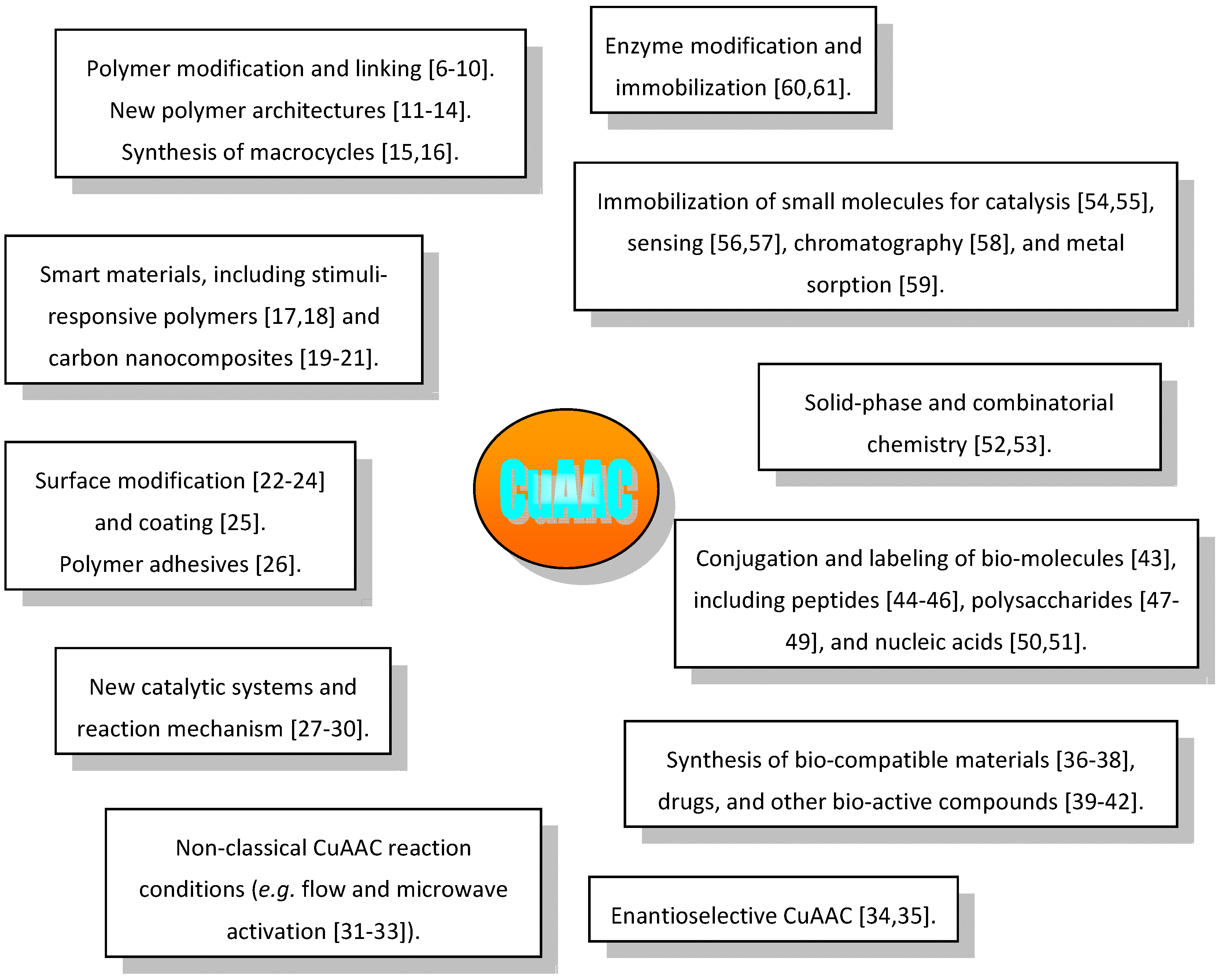
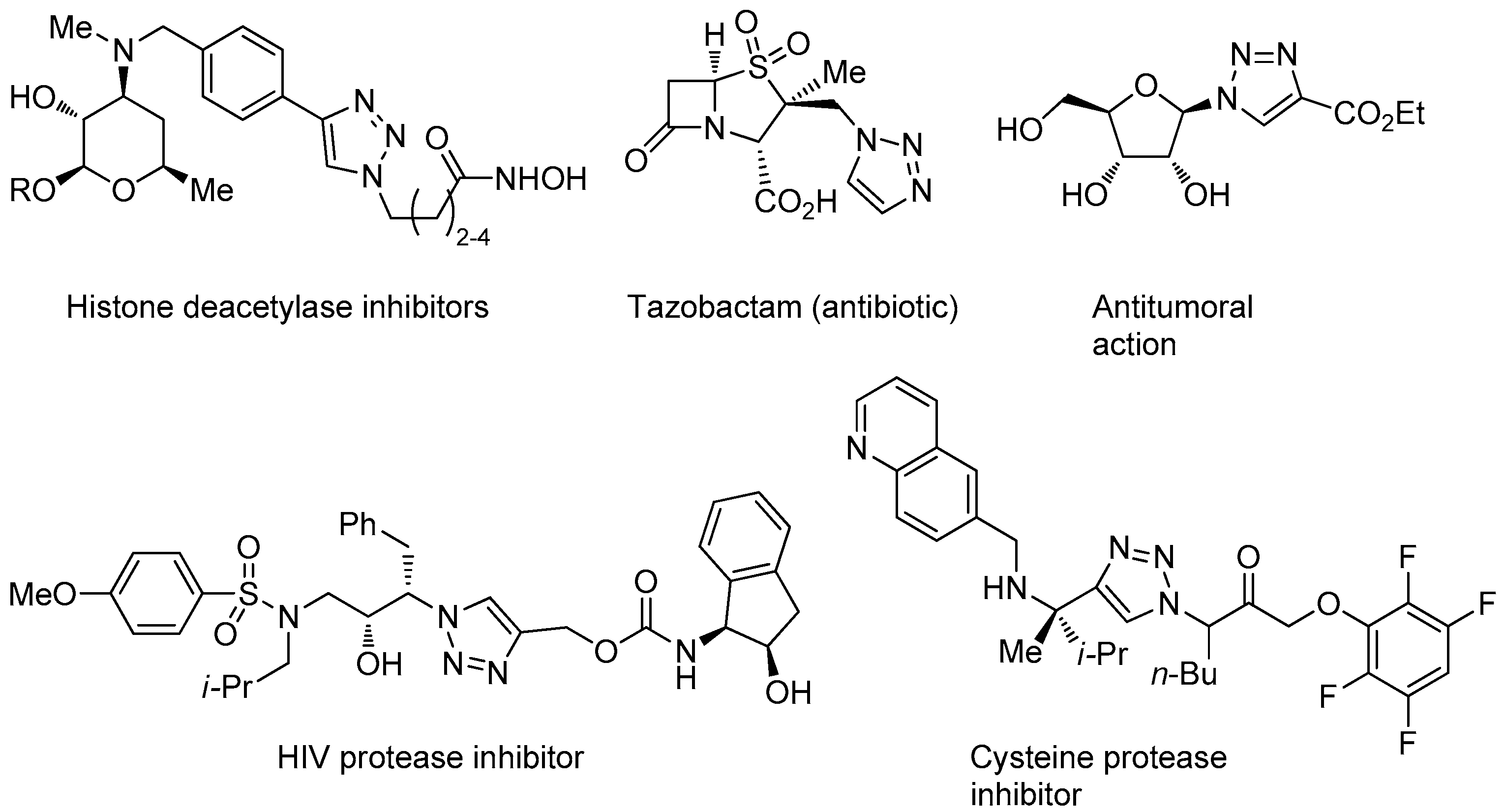
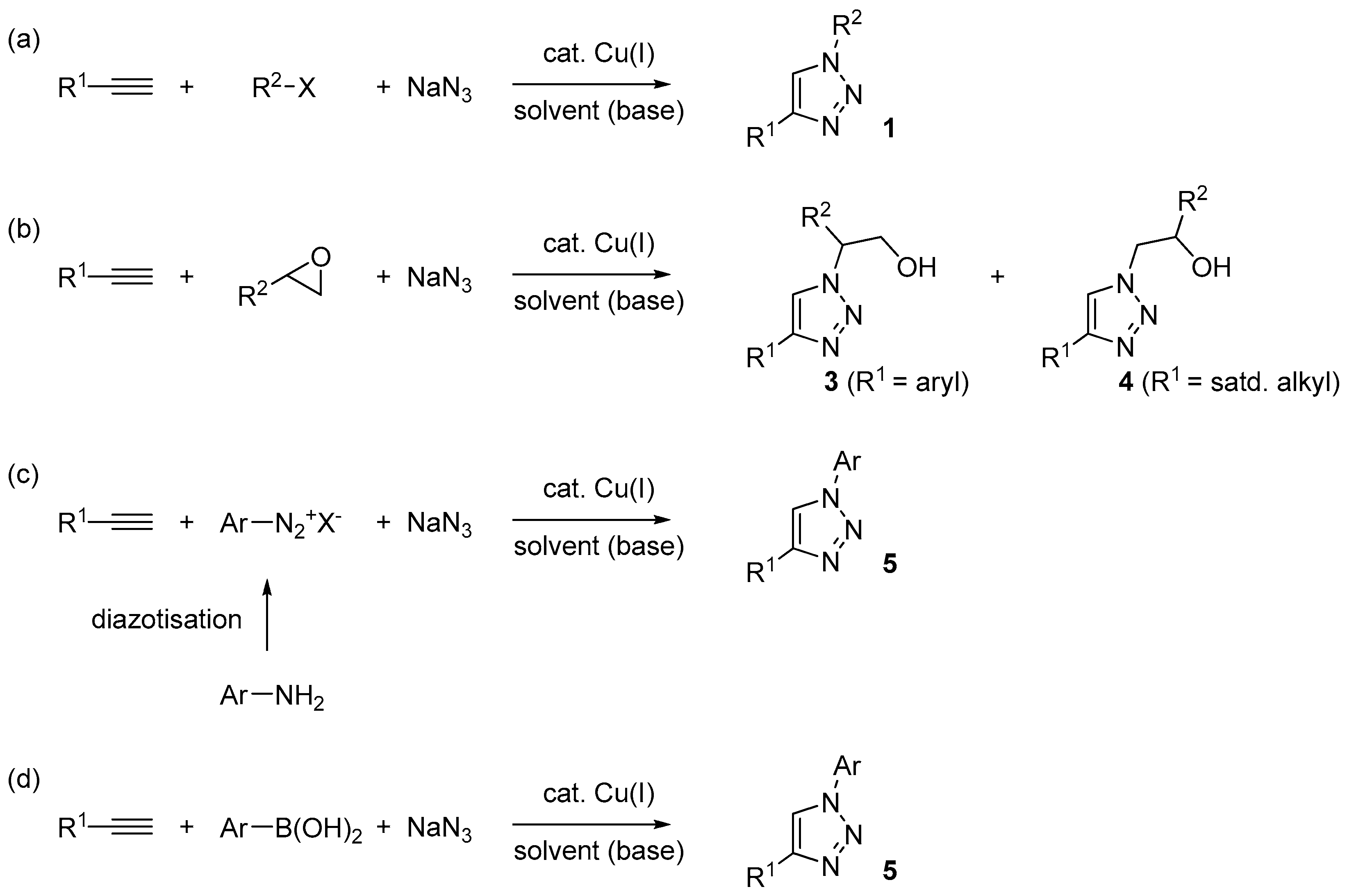

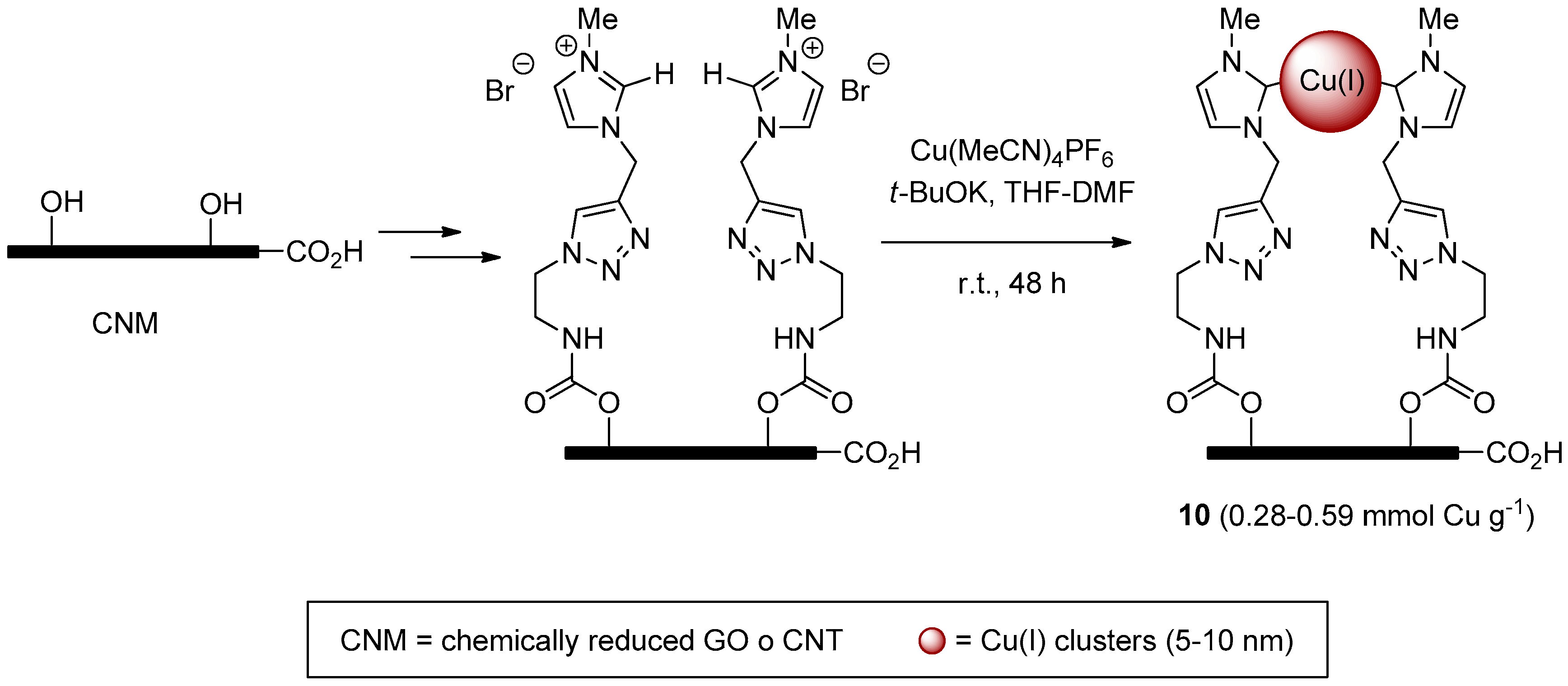


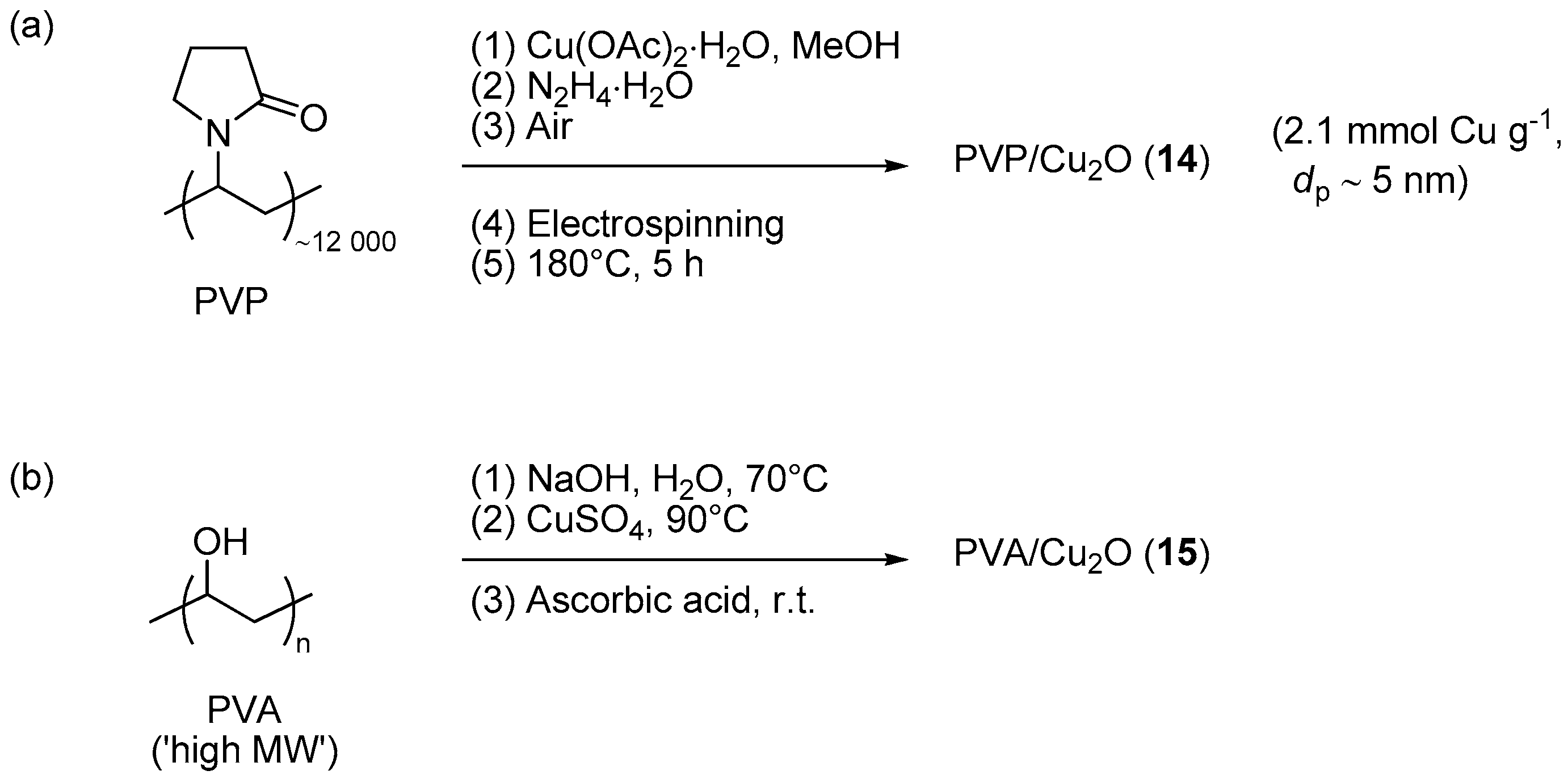




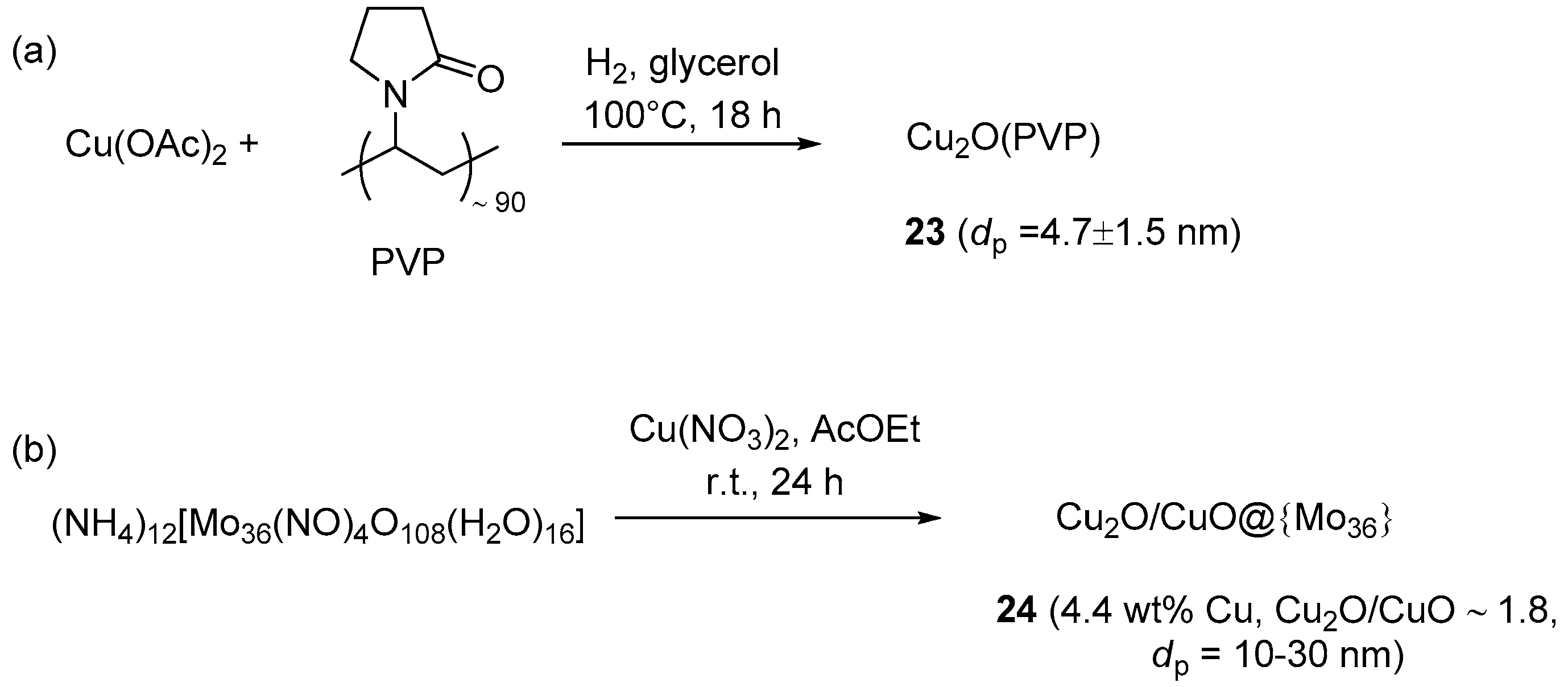

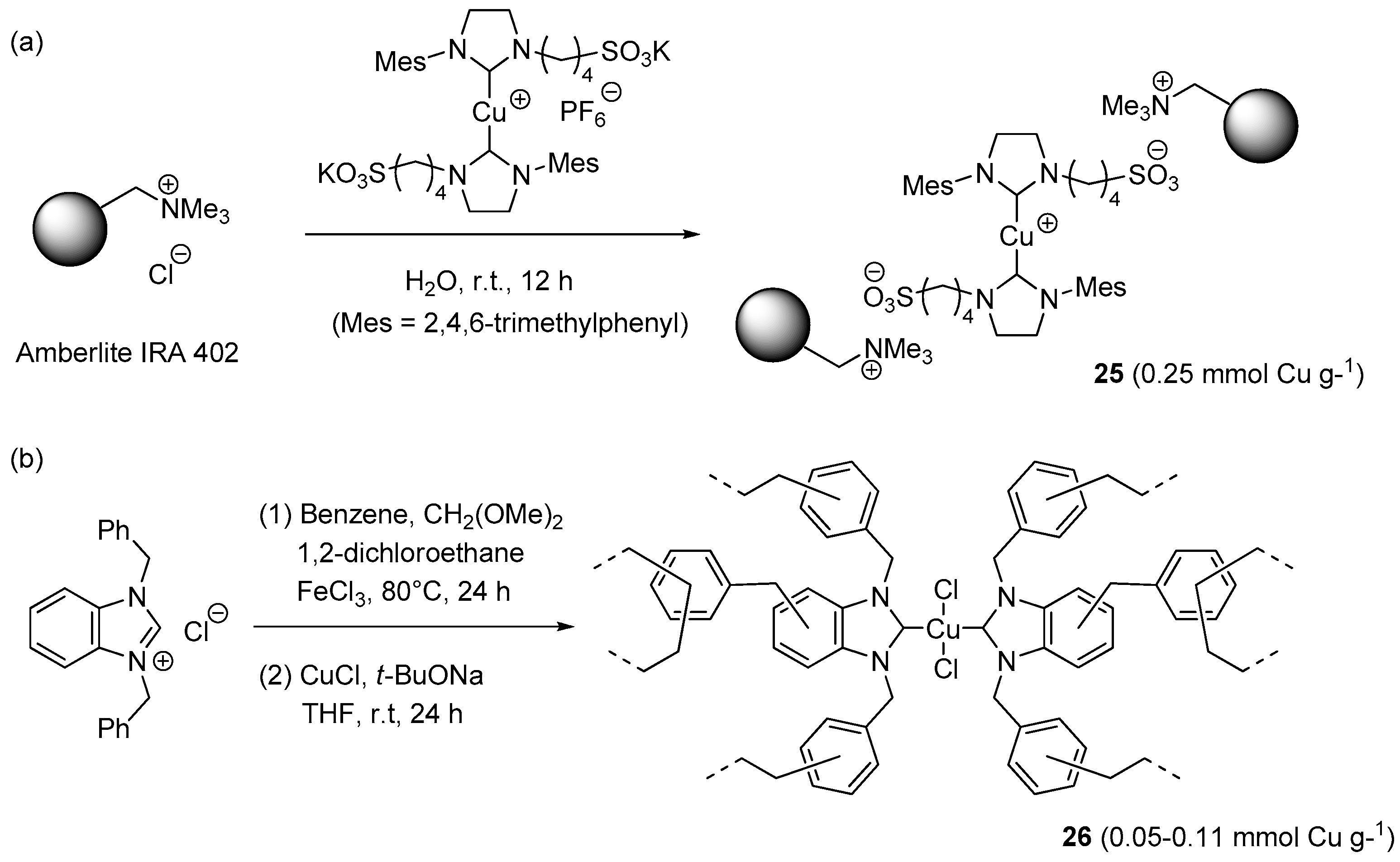

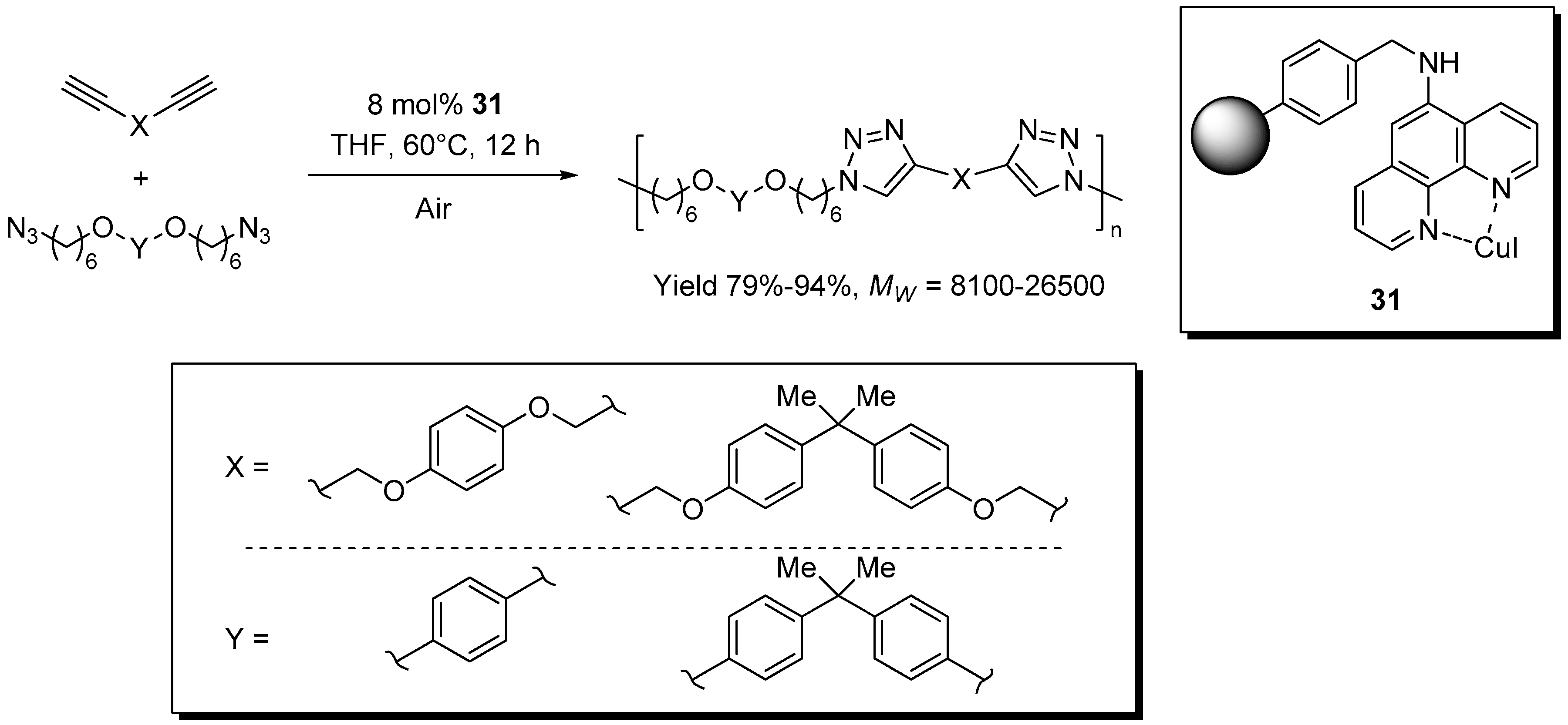
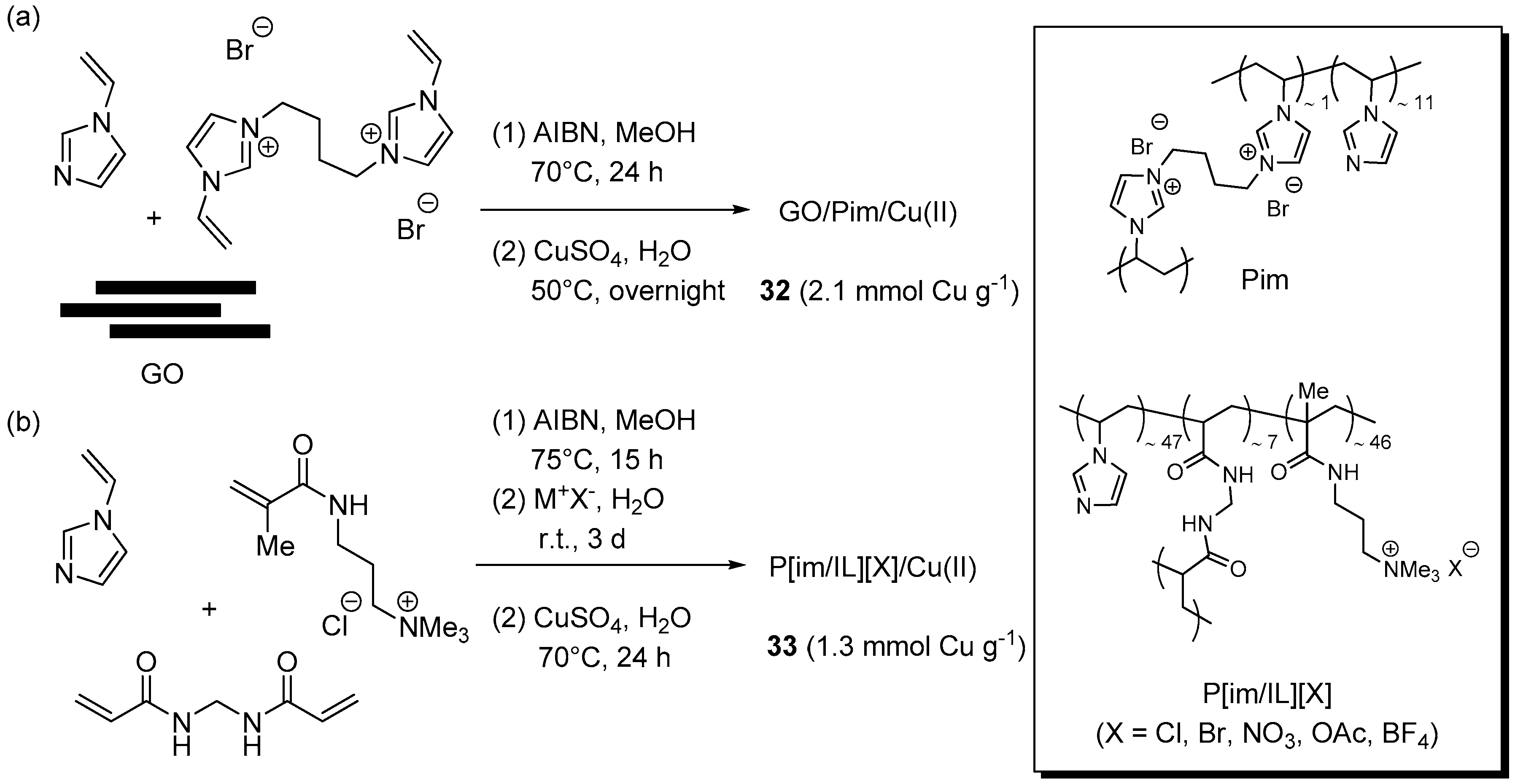
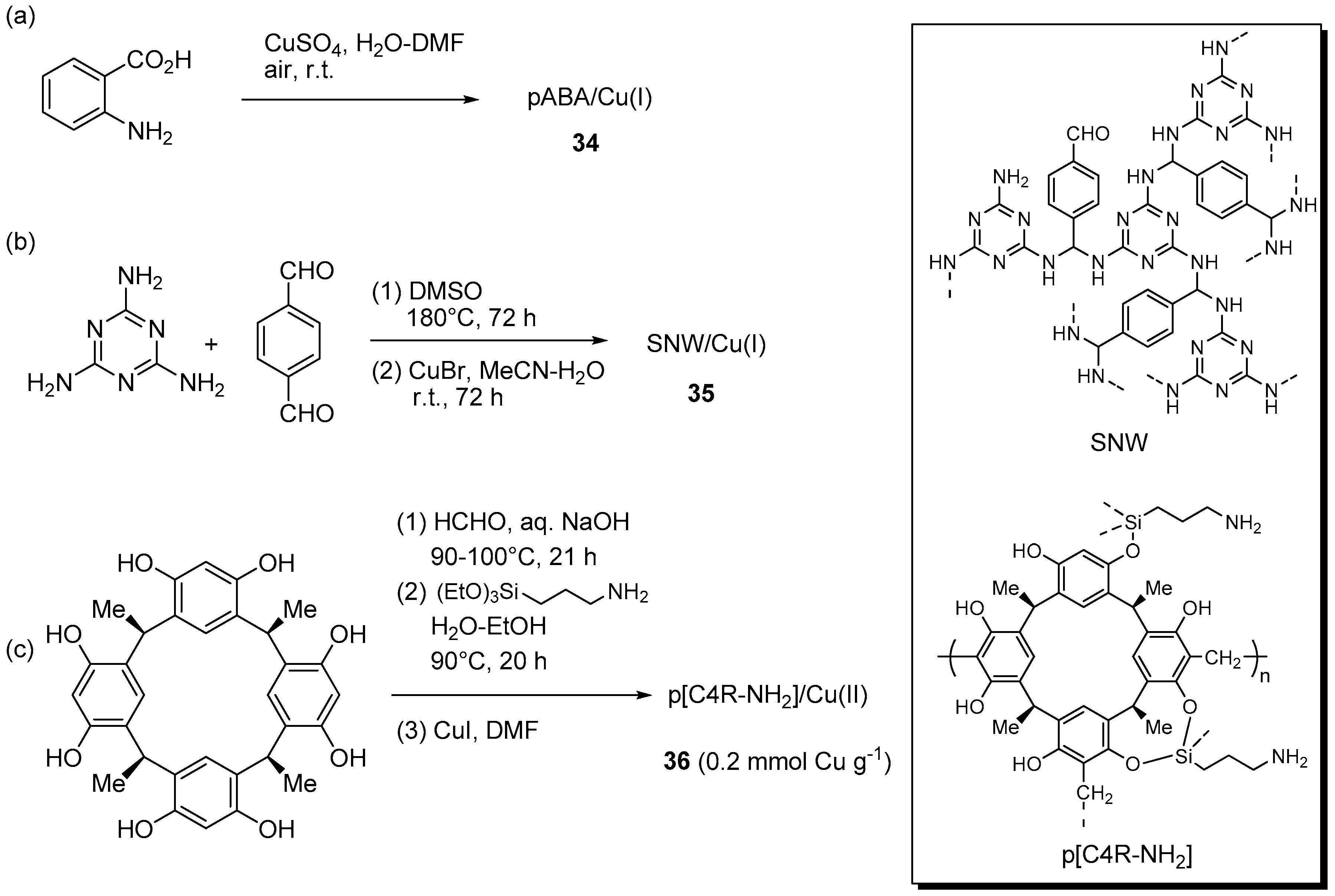

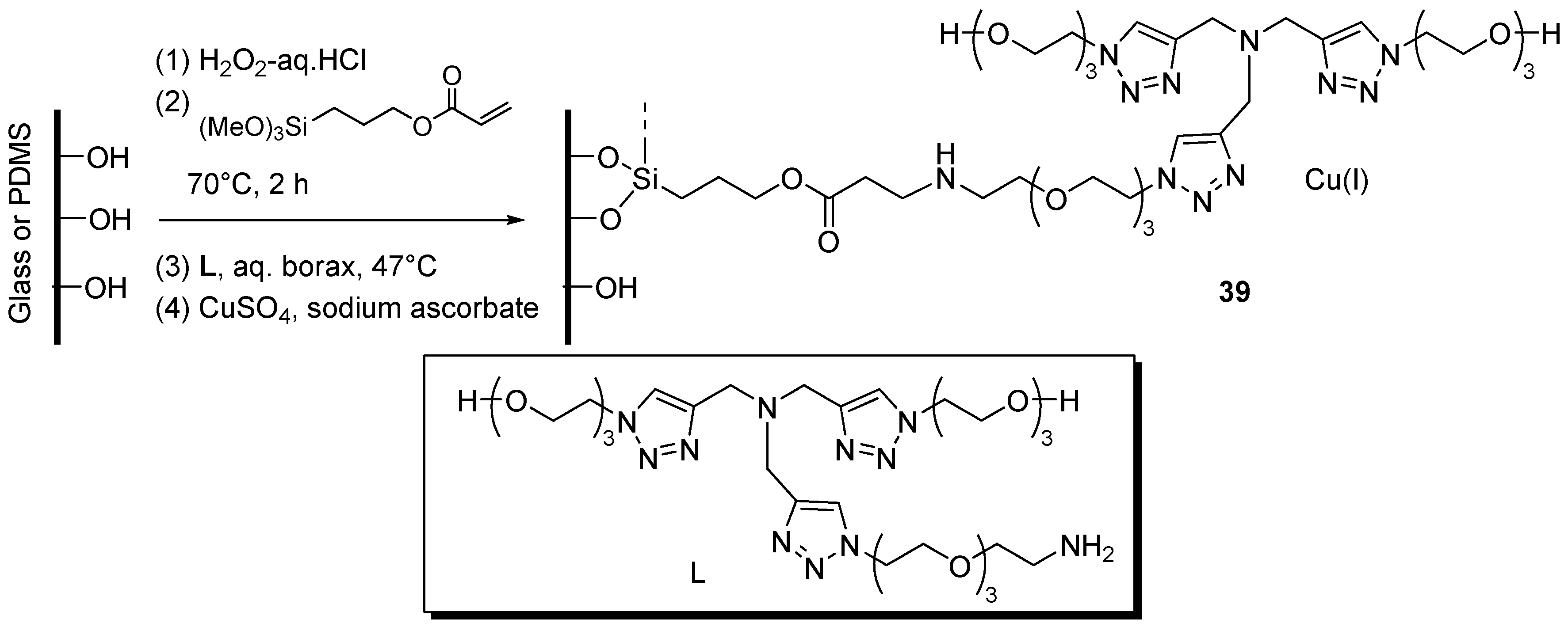
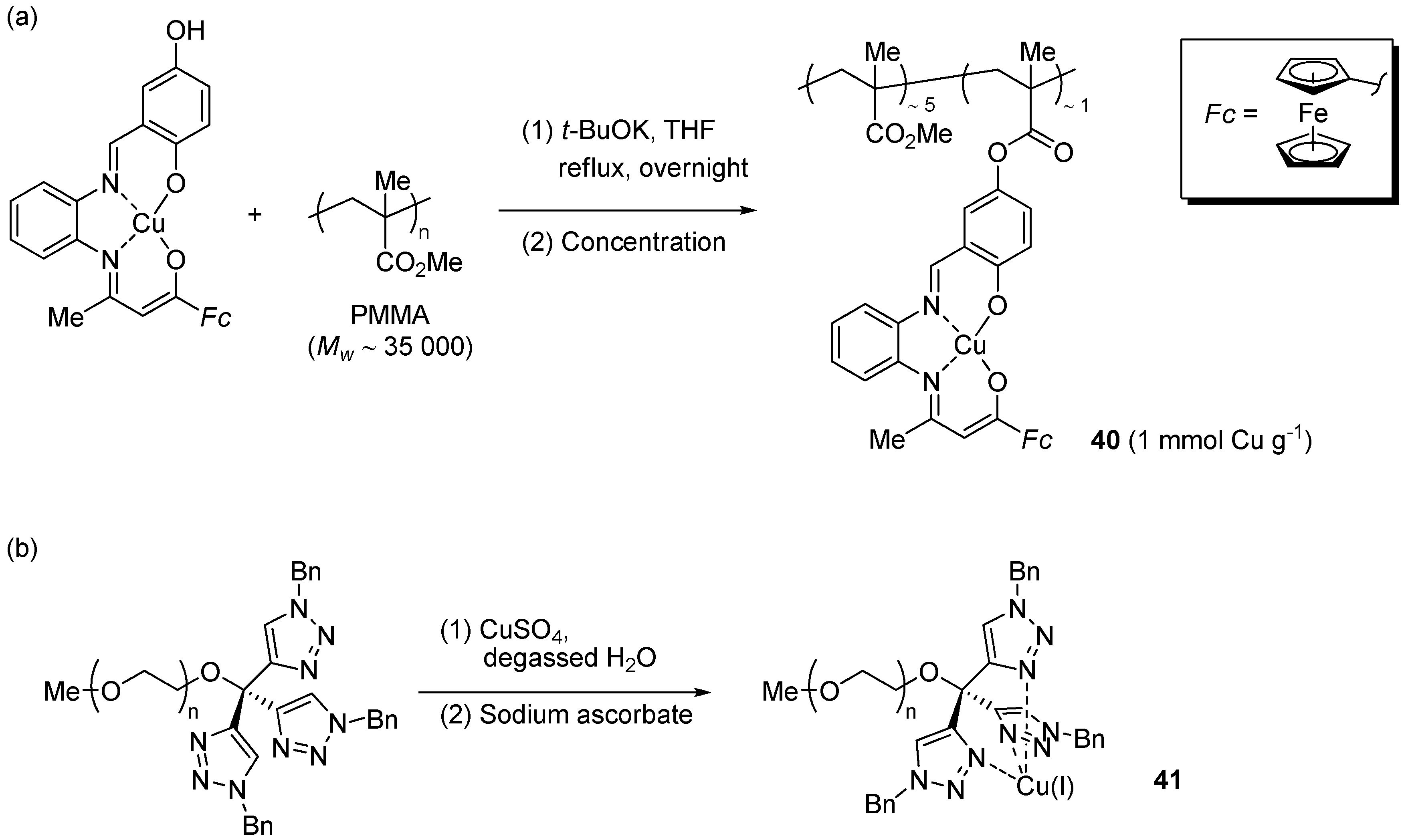
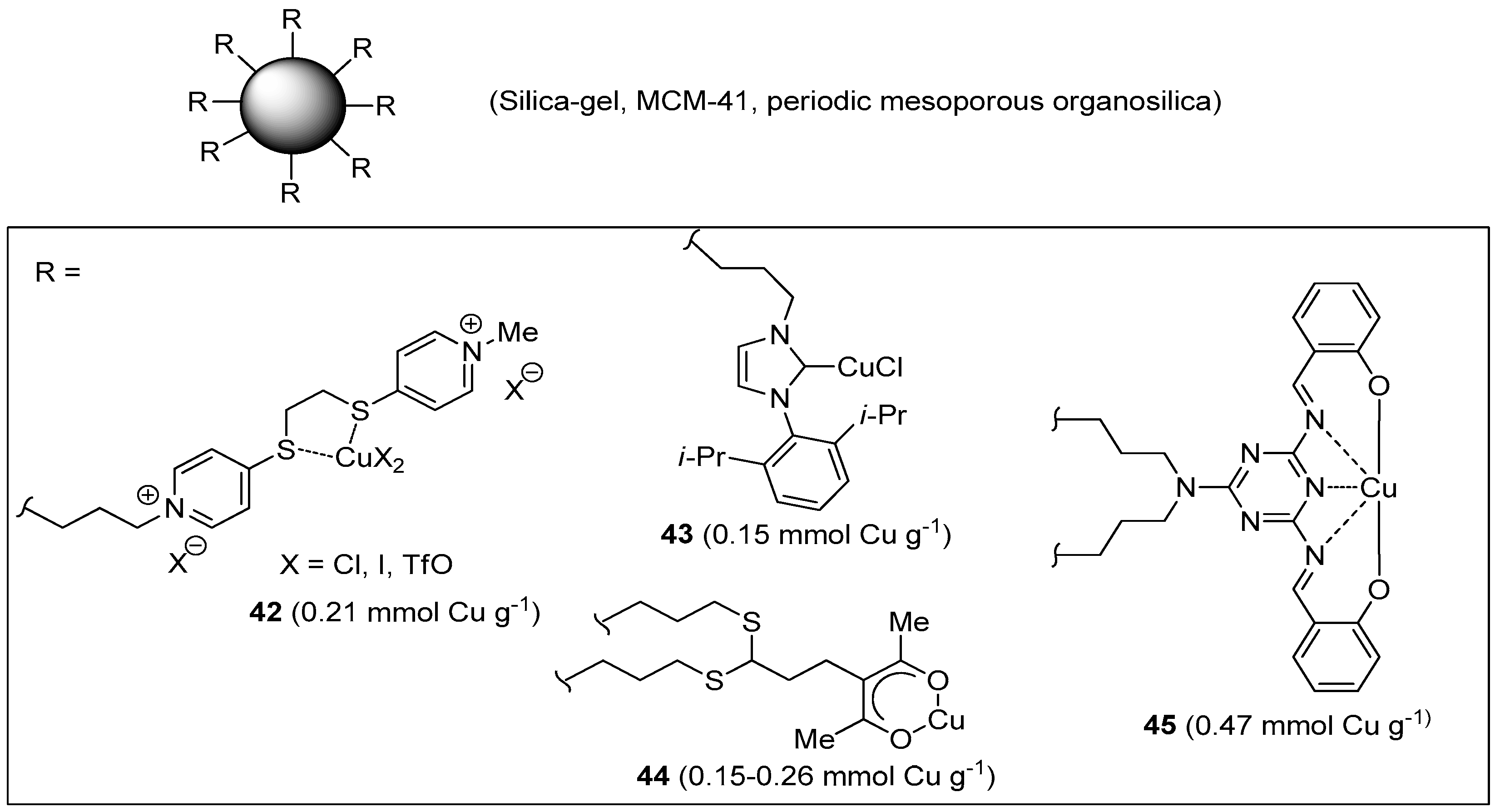

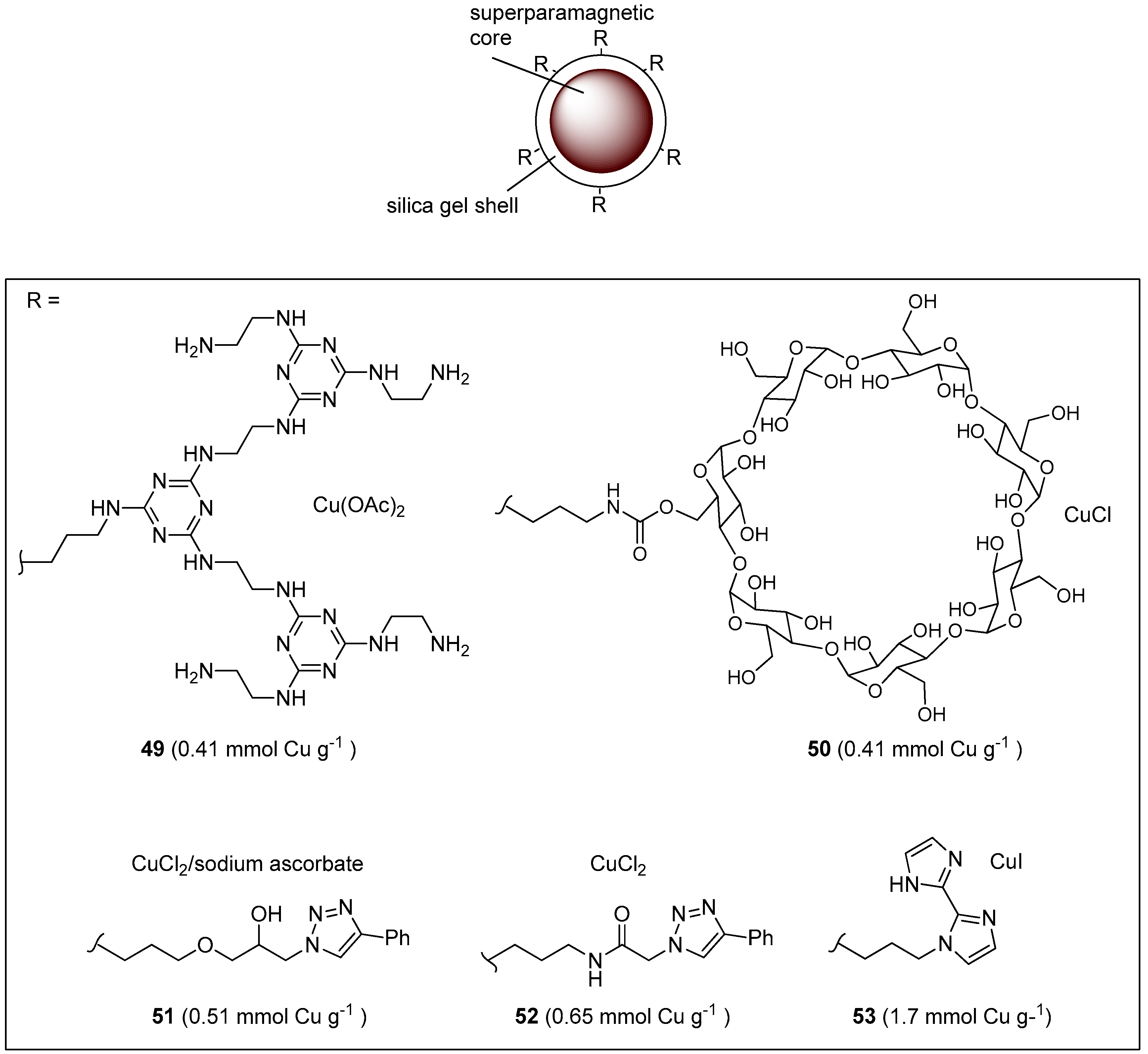

© 2016 by the authors. Licensee MDPI, Basel, Switzerland. This article is an open access article distributed under the terms and conditions of the Creative Commons Attribution (CC-BY) license ( http://creativecommons.org/licenses/by/4.0/).
Share and Cite
Mandoli, A. Recent Advances in Recoverable Systems for the Copper-Catalyzed Azide-Alkyne Cycloaddition Reaction (CuAAC). Molecules 2016, 21, 1174. https://doi.org/10.3390/molecules21091174
Mandoli A. Recent Advances in Recoverable Systems for the Copper-Catalyzed Azide-Alkyne Cycloaddition Reaction (CuAAC). Molecules. 2016; 21(9):1174. https://doi.org/10.3390/molecules21091174
Chicago/Turabian StyleMandoli, Alessandro. 2016. "Recent Advances in Recoverable Systems for the Copper-Catalyzed Azide-Alkyne Cycloaddition Reaction (CuAAC)" Molecules 21, no. 9: 1174. https://doi.org/10.3390/molecules21091174
APA StyleMandoli, A. (2016). Recent Advances in Recoverable Systems for the Copper-Catalyzed Azide-Alkyne Cycloaddition Reaction (CuAAC). Molecules, 21(9), 1174. https://doi.org/10.3390/molecules21091174





